#coming up with the least analogue horror analogue horror plot
Text
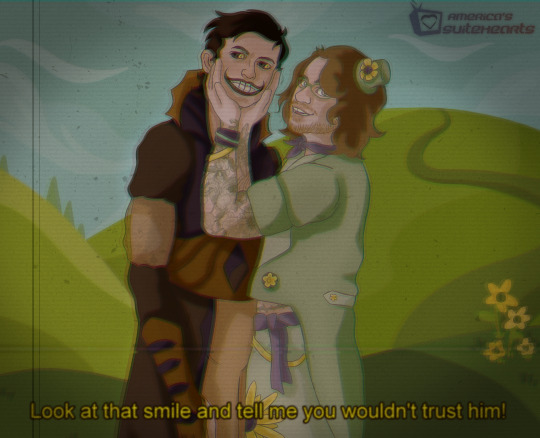

What if we were friends and we were also trapped in a sesame street knock-off? That would be fun, I think
#coming up with the least analogue horror analogue horror plot#it's because there's no horror in it#just shenanigans#benzedrine will appear in the next drawings#and at some point I'll explain the lore. Today is not that day#fall out boy#fob#pete wentz#andy hurley#joe trohman#fall out boy fan art#america's suitehearts#folie a deux#may be suitehearts
429 notes
·
View notes
Text
One of the fun parts of the seven AUs is showcasing Azula's intellect in seven different ways:
In By Fire and Water and Earth and Air she grasps the full implications of multiverse theory and then digs out Zuko's old 'storybook' that happens to include some in-universe major weaknesses of the Azar in plain sight for someone with that knowledge to exploit and decides she's living in the Dunwich Horror, not 40K and proceeds to act accordingly. I would compare her to a Challengers of the Unknown type in certain aspects who develops the theory into a very sophisticated sense and it shapes a big element of her future path in the time before and during that of Avatar Korra.
In the Dragon-verse she hits the Fire Nation the hardest blows it can be hit, not by one person doing the Superman theme and embodying the worst elements of the superhero genre, but by setting in motion an avalanche and appealing to the more optimistic aspects of this universe where optimism is rewarded. In this AU, at least, humanity is 100% in the 'basically good' category and people who realize they were lied to actually give a shit about that and it starts the dominoes rolling. Real life doesn't entirely bear this out about humans in meatspace but that's the fun of writing stories, neh?
In the Sins-verse she not only has the same 'reinventing Firebending' element as in the Continuation-verse but in this AU she independently rediscovers it without need for the Dragons at all, striking an equally shrewd blow at the myths that her ancestors were trying to wrap around her. She also spends an otherwise relatively quiet time making good use of her training in a safe environment and creating a massive ripple effect that turns butterflies into a swarm of Mothras.
In the Continuation-verse she independently discovers the alternate means of Firebending, true flight for Firebenders (and teaches the secrets to Holeun, for starters), and invents straight up powered armor, and in accordance with her comics self the techniques of Darth Sidious style multiple lightning bolts, straight up lightning summoning...and in all universes she develops her unique brand of charged firebreathing because blue fire breath = inevitable Godzilla analogue.
There will be equivalent aspects in the other AUs that aren't written up fully yet, because this is where a lot of the fun part comes in. Writing 'Azula beats up everyone' is boring. Showing her actually *using* her intellect and using it for non-war things offers a lot more room for what to do with plot.....and in terms of war things using it as a general, not a glorified colonel who shoots lightning.
#atla aus#azula#azula is a nerd#seven different ways of exploring that theme#azula is also an overachiever independent of her background#it shaped that trait initially into negative aspects but it also has its positive ones
10 notes
·
View notes
Text
wandavision: the criticisms post
tl;dr: i liked the show, but there were aspects that were annoying and dumbfounding to me and here’s the post that covers That ¯\_(ツ)_/¯
this was gonna be my comprehensive wandavision review post that had both cons and pros, but the cons kind of ran away from me lsdfjs SO YOU’RE GETTING THIS FIRST. if you find my views diverging from yours in either direction, you’re valid, please don’t shiv me. this is just how i Feel in a somewhat shitposty (as per usual) format. 😔
the big con list:
the way wanda’s actual villainy gets brushed away by the narrative:
or specifically the way wanda strolls past the people she mentally tortured and traumatized for a week to apologize to monica, who then goes “gg girl i would’ve done the same :)” and then wanda leaves that entire mess—that she caused—behind her and bails lol.
that scene is a microcosm of my problems with this show’s attempt at portraying what the creators have described as her ““complexity””. they want us to feel sorry for her, but not in the way that we can sympathize with walter white while still acknowledging he’s broken bad. rather, this show seemed to want to paint her as more of a victim than the people she victimized. they still want her to come out looking heroic and triumphant and rewarded from her journey with new powers, a new superhero outfit, a new superhero moniker.
and that falls flat when you realize she’s basically been a self-absorbed asshole throughout the course of this show. she was confronted no less than four times, and told point blank that a few thousand people were suffering under her control. that is not something we can excuse with depression and denial. that means that at multiple times she is making at least the subconscious choice that her happiness matters more than the wellbeing of her meat puppets, which includes children, across the span of a week.
i don’t see monica rambeau “doing the same thing.” the fact that they made her say it while the townspeople glared on in miserable silence just rubbed me the wrong way.
if they really wanted to make her responsible for westview, while also wanting her to come out looking remotely good, they needed to invest in a much more substantial redemption arc for her than “i didn’t mean to, gonna go self-exile now.”
or even holding everything else constant, they could’ve delivered a more nuanced take where westview was in dire straits before her arrival. the westview she initially drove through already looked economically depressed, so i don’t know why they didn’t just follow through with this. but they could’ve made it so that by granting herself happiness and prosperity, she could’ve spread that genuinely throughout the citizens. instead of hex vision waking norm up in horror, you could’ve had him begging to be put back under.
that way, her decision to accept and face reality head on could also be reflected by the people of westview. where everyone, perhaps aided through wanda’s mind link, decides they shouldn’t let fantasy consume themselves at the expense of improving their actual reality. there’s still moral ambiguity, there’s still mistakes being made, we can still side-eye wanda for doing the equivalent of drugging people, but at least these npc’s would've gained something from wanda blundering into their lives.
but no she made 3 thousand people suffer through the literal plot of Get Out, giving them life-long ptsd and trauma with nothing good, and i think that’s bad. if she has more haters after this series, i can’t even blame them.
but apparently she has a shit-ton more fans after this series, so... OH WELL, IT IS WHAT IT IS sdkfjkls
TYLER:
which brings me to the thought that, if this show had hayward acting like a three dimensional human person with the bare minimum intellect required to run SWORD ... instead of an incompetent jackass scooby doo villain ... a lot of us would be spamming #HaywardWasRight.
tyler hayward might legitimately be the worst villain mcu has ever produced, like edging past malekith. is he supposed to be an analogue to real world tr*mp appointed deputies? unlike agatha, he’s not even entertaining to watch. he’s the ted cruz of the mcu, which is bizarre when he was introduced as the strict but not particularly vexing or unreasonable successor to maria rambeau in episode 4.
it ended up feeling extremely contrived how the show attempted to aggressively signal us with “hayward bad” and “wanda good, actually” through the lens of monica, darcy, and jimmy. it’s like they had to make hayward come across as Extremely Dumb in order to make wanda come across as the more sympathetic party, when she was the one doing [gestures vaguely at wall of text above].
and SPEAKING of agatha:
she also ended up being the exact kind of simplified reductive cackling “gimme ur powers wanda” evil super witch that i didn’t want her to be. that’s all.
the theorybaiting:
i didn’t care about the lack of mutants/doctor strange cameo (lol what happened, charles murphy)/multiverse/blue marvel/reed richards/mephisto/nightmare/chthon (altho we did get the darkhold wink wonk) so much that it ruined my experience. ralph bohner was disappointing, but i got over it.
my issue here is more that they deliberately baited a more interesting story than they delivered, and i think they shot themselves in the foot with that. the first 7, even 8 episodes had set up this atmosphere of mystery and intrigue, only for them to wrap up all these questions with the most boring, uninspired answers possible. question: what does hayward want and what is he up to? answer: hayward is simply a stupid dingus. question: who is agatha harkness and what is she up to? answer: an evil witch who just wants to steal yo powers. question: who is fietro? answer: lol boner. question: was it wanda all along? answer: yes, but no it was actually agatha, but actually yes, but she didn’t mean to and is kind of sorry and now she’s gonna fly away so have fun with your ptsd, westview.
?????????
yeah they could have ... done some of that better.
the pacing in the end:
i remember when they said it was gonna be “around 6 hours,” and we got 4 and a half hours of actual content instead... they should have given us that extra 1 and a half hour to flesh out the finale.
the sitcom portion was fun, it feels like the sitcom portion was prioritized in the writing room, and that the overarching narrative beyond the sitcom suffered to accommodate it. when it came time to break away from the format, they stumbled.
so in the beginning, there were segments that felt authentic to the era but were fairly critiqued as “dragging on” ... and in the final episode, we had... the final episode.
monica and wanda’s ending conversation felt unsatisfying, both wanda’s apology and monica’s acceptance of it rang particularly hollow [also gestures vaguely to wall of text above].
the appearance of white vision should have had much more of an impact on ... everyone, especially wanda. except the dude just dips and no one mentions him ever again.
i feel like hex vision being revealed as the the vision that had always been ~part of her should have also had more ... fleshing out.
darcy and jimmy basically ended up having no arcs in this show. they served as stand-ins for the audience, and because they were written to feel sorry for wanda (in a situation where she was absolutely deserving of more scrutiny), the audience too gets manipulated toward doing so.
there’s probably more to add but i’m running out of brain juice BUT THOSE WERE THE BIG ONES STORY-WISE
#wandavision#wandavision spoilers#i will do Things I Liked... later#I TOLD YOU MANY THOUGHTS HEAD FULL#all i can say is that i can't wait to consume fatw in a much more lowkey easy breezy way sdklfjdsl
48 notes
·
View notes
Text
TerraMythos’ 2020 Reading Challenge In Review - 8/10s!
See Master Post
Here’s the 8/10s! This is basically the mid-level “stuff I liked” rating.
1. How Long ‘Til Black Future Month? by N. K. Jemisin (Full Review Here)
The 8/10 on this is a little misleading, as it’s an average score among 22 stories. Anthologies are basically never going to be my highest-rated works because to me short fiction is hit-or-miss. As you can tell from my actual write-up, there are a lot of great stories here; Jemisin is just a fantastic writer. The Trojan Girl, Valedictorian, The Evaluators, The Narcomancer, and Too Many Yesterdays/Not Enough Tomorrows all live in my head rent-free. There’s just some that also didn’t click with me.
2. All Systems Red (The Murderbot Diaries #1) by Martha Wells (Full Review Here)
If you peeked at the 9 and 10 lists you know I loved this series, lol. This one ranked a little lower than the others because it’s super short! Just as I started getting attached to Murderbot and interested in the world, the book ended. It was a good hook to get me further into the series but hard to rank on its own. The other novellas ranked higher since I was more familiar with Murderbot by then. I’m very glad I stuck with it and kept reading!
3. City of Saints and Madmen (Ambergris #1) by Jeff VanderMeer (Full Review Here)
This is the first book in the pseudo-trilogy that is the Ambergris series. It’s basically a short story collection, and boy is it weird! There’s clearly something wrong with Ambergris as a city, and it’s hard to parse fact from fiction when the stories intentionally contradict each other or obfuscate information. There’s a ton of hints that don’t pay off until Finch, which is totally bonkers. Anyway, I really liked the horror/historical stories (yes those are basically the same when it comes to Ambergris) -- The Hoegbotton Guide to the Early History of Ambergris, The Transformation of Martin Lake, King Squid, and my personal favorite The Cage. The other stories just ranged from mildly interesting to meh.
4. Aristotle and Dante Discover the Secrets of the Universe by Benjamin Alire Sáenz (Full Review Here)
I can totally see why this is a classic in LGBT YA fiction. The writing and love story are both fantastic. As someone perpetually closeted in real life, the struggle of Ari realizing he’s in love with his best friend hits close to home, and is clearly drawn from the author’s own relationship with his sexuality. I really like that both of the leads’ families are integral to the story, and while Ari’s personal arc is a family conflict, it’s refreshingly not due to the LGBT stuff. This book would be an easy 10/10 but something happened near the middle that totally killed the pace for me. Thankfully it does get better in the last third or so.
5. The Siren Depths (The Books of the Raksura #3) by Martha Wells (Full Review Here)
This book is probably my favorite in the original trilogy; I like the reveal of Moon’s past and the complicated emotions associated with that. The Fell are genuinely creepy villains played to their full potential as well. The Siren Depths also introduces two of my favorite characters, Malachite and Shade. It’s got the emotions! It’s got the action! It’s got the kinda-horror! The main thing that dragged down the score is the ending, which felt rushed and tied up way too quickly.
6. The Cloud Roads (The Books of the Raksura #1) by Martha Wells (Full Review Here)
As an introduction to the Raksura series, I really liked this book! There’s a sense of this huge setting with lots of interesting worldbuilding and development. I’ve said it a lot, but I like that it’s a fantasy setting with zero humans or recognizable fantasy races. It’s also super cool to have the main characters able to shapeshift and fly! Moon learning about the Raksura and their culture feels natural because he’s an outsider. I also like his arc; how he mistrusts/allies with the Raksura for convenience, then gradually finds his place among them. At this point in the series the Fell weren’t especially interesting villains, but (spoiler) the series does eventually address this.
7. Middlegame by Seanan McGuire (Full Review Here)
So I really like the concept behind this one -- twins created by shady alchemical experiments get tossed into the real world in order to observe their natural development. While intentionally kept apart, they manage to find each other nevertheless via telepathy. There’s this grand scheme for the villains to steal the twins’ power and become a god? And at some point the reader realizes there’s time loops and stuff where they’re trying to prevent certain bad endings (hello Zero Escape)? Platonic soulmates?! Just... a lot of interesting stuff going on. I think what kept this from a 9 or a 10 for me is much of the book reads like contemporary coming-of-age fiction, which isn’t what I was looking for with a concept like this. Technically the “ordinary” nature of the first half is a façade because Plot, but... you still have to read through it.
8. A Short History of Nearly Everything by Bill Bryson (Full Review Here)
This is an interesting nonfiction work that summarizes major scientific knowledge in terms a layman can understand. Bryson is actually a travel writer, but consulted dozens of experts in order to write this book and cites the hell out of everything. I think he does a great job presenting accurate and accessible information. Even stuff I learned in school is explained in ways that make more sense than how I was taught-- like ice ages. I also learned lots of interesting facts! My main issue is there’s a heavy focus on individual scientists, many of whom were boring. And while this isn’t the book’s fault, some of the info is outdated. I think this would benefit from a revised edition.
9. Wolf by Wolf (Wolf by Wolf #1) by Ryan Graudin (Full Review Here)
Absolutely fuckin’ bonkers concept. Alternate “the Nazis won” history, starring a Holocaust escapee who can skinshift, posing as a professional motorcyclist, trying to compete and win an annual Reich-sponsored race, in order to get a private audience with Hitler and murder the shit out of him? Probably the most surprising thing about the premise is it mostly works. I really like the deliberate pacing through the tense motorcycle race, the level of deception Yael has to maintain, and the harrowing flashback sequences. Sometimes the symbolism is a little heavy-handed, and I wasn’t a huge fan of the generic antagonistic YA love interest character Luka, but overall I was pleasantly surprised by this one.
10. A Conspiracy of Truths (A Conspiracy of Truths #1) by Alexandra Rowland (Full Review Here)
This takes place in a fantasy world with analogues to real-world nations. The main character, an old man named Chant, is a professional storyteller who is arrested for supposed witchcraft in the Eastern Europe-esque country of Nuryevet. While it’s clearly a farce, he’s screwed over by the local political system and imprisoned. Faced with possible execution, Chant uses his gift for storytelling to manipulate local powers, and accidentally starts a political revolution in the country. Whoops!
I liked the book’s meta-commentary on storytelling, and it features a lot of wonderful side-stories told by Chant and other characters. Oddly enough, the economics are super interesting (a trait shared with the sequel). My main criticism is most of the political intrigue goes down off-screen; we just learn about it through other characters. While that makes sense with an imprisoned protagonist, it’s not the most exciting approach. I ended up liking A Choir of Lies more, but this one was still good.
11. The Serpent Sea (The Books of the Raksura #2) by Martha Wells (Full Review Here)
Boy did I read a lot of Martha Wells this year. This is the last one! This is probably my least favorite of the series; very much a filler/side-story. Nevertheless, it’s an entertaining entry on its own merits. The leviathan city is distinctively gross, and I liked the evil magister antagonist and his creepy-ass museum. This is also where we learn about Chime’s powers, which continue to be relevant through the series. But I don’t have a whole lot to say beyond that. It’s a solid entry that doesn’t change much.
1 note
·
View note
Text
Episode 92: Monster Reunion
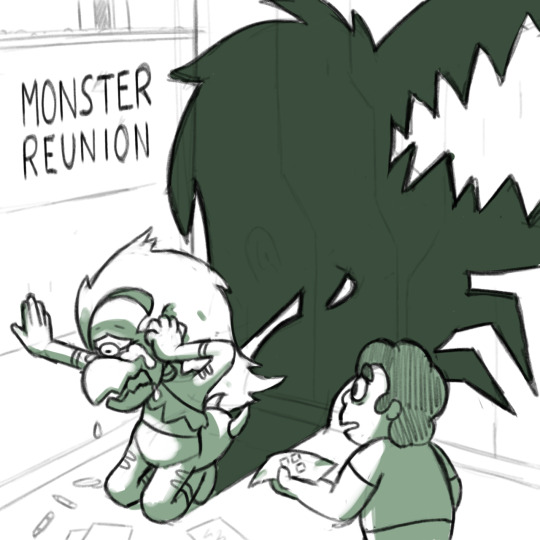
“I have to try.”
The tragedy of Nephrite is Steven Universe’s longest side story, beginning with the very first episode and concluding five years later in the final episode of the show’s original run. How we feel about Nephrite at any given time indicates how we’re made to feel about Corrupted Gems as a whole at that point in the show. After Gem Glow, they’re monsters of the week. After Monster Buddies, they’re innocent but violent victims of...something. And after Monster Reunion, we know what that something is.
Ninety-two episodes in, we know of Yellow and Blue Diamond. We know they’re part of a a group called Great Diamond Authority, acting as Gem Matriarchs. We’ve seen an artistic representation of a third Diamond on the Moon Base. We’ve seen a four-part symbol with a white, yellow, blue, and pink diamond united as one. We got a hint of their musical cue as the Gems abandoned Earth in a flashback. And because the Diamonds are in charge, we also know that they’re responsible for some terrible things, from the forced fusion of Gem Shards to seeking of destruction of planets not only for reproduction, but revenge. The information is dripping in, and these Gems are shaping up to be the villains of the series, and thanks to that knowledge, all it takes is one sketch to emphasize their most heinous crime.

This is the episode where the horror of corruption sinks in, in the same way Keeping It Together reveals the horror of Cluster Gems. The Mother Centipeetle was a monster, and Centi was a pet, but this version trying desperately to communicate before she loses her sanity again is a person. She has memories spanning millennia but was trapped by her mind and her body by her own leaders. After a string of Beach City episodes with purely personal stakes, Monster Reunion’s depiction of a personal struggle representing an atrocity affecting a planet’s worth of Gems hits like a freight train. This isn’t just something the Diamonds did to their enemies: Nephrite, alongside countless other Corrupted Gems caught in the crossfire, was loyal to Homeworld, but that meant nothing.
Between the Cluster Gems and the Corrupted Gems, the Diamonds prove that they’re not content with just destroying the bodies of their opponents, but the souls of anyone that inconveniences them. We’ll learn a bit more about it in Nephrite’s fourth episode, Legs from Here to Homeworld, where it seems this corruption was unintentional (or at least unknown by Blue and Yellow Diamond), but Monster Reunion galvanized me against the Diamonds in a way no other episode has, and it does this by giving us a single, concrete character to sympathize with.

This is the second time this season Raven Molisee and Paul Villeco have given Steven an extensive conversation with an entity incapable of full communication, but unlike Gem Drill, Nephrite allows these artists to fully utilize their gift for character animation to tell their story. Molisee’n’Villeco episodes are distinguished by more exaggerated expressions than usual (see: the first act of Coach Steven, the climax of Rose’s Scabbard, Amethyst throughout Reformed, Steven-as-Lars in The New Lars), and that makes all the difference in enhancing our ability to relate with a growling alien cyclops bug. We don’t need words to tell us when Nephrite is scared, happy, curious, angry, or sad (we don’t even need tears to tell us that last one, but oof are they effective), and we’re able to empathize with her on a primal level thanks to her vivid expressions.
The other half of the Nephrite formula is master vocalist Dee Bradley Baker, who’s already performed as every Corrupted Gem in the series, as well as Lion. Baker’s prolific ability to give life to non-human characters make him virtually impossible to overrate, and he uses that gift to convey comprehensible communication from Nephrite with nothing but chirps and squawks. This is so much more effective than the cacophony of voices from the Cluster, allowing for an actual conversation of sorts between Steven and Nephrite.
This would be a very different episode if Nephrite was still just Centi from Monster Buddies, and we have Molisee, Villeco, and Baker to thank. It’s not enough to feel bad for an animal in pain again: we need to see, for lack of a better term, the human suffering of it all. And I feel so bad for this woman who doesn’t even get to have a real name for another sixty-one episodes.
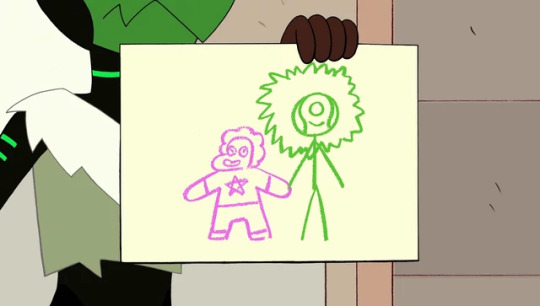
The conversation itself centers around a terrific use of flashback. As Steven reminds Nephrite (and the audience, because it’s been a while since Monster Buddies) of their history, we get depictions of the past that fully resemble Steven’s experiences. But Nephrite can’t talk, so we don’t even get the simplified silhouettes that accompanied stories from Garnet in The Answer or Lapis in Same Old World. We get crayons and stick figures, the most childish means of communicating, that slowly gain animation as the story picks up.
Steven’s narration is a constant reminder that Nephrite doesn’t have a voice of her own, and that we’re getting bits and pieces of what actually happened. She can still sing along with him in her own way, and performs a flawless diamond salute, but can’t tell Steven the name of her commander, or how she felt about her crew, or any actual tales of the war. Honestly the most telling image is Nephrite’s very first picture, revealing that she sees herself as herself despite having never met Steven in that body. This is a sentient person, and we’re made to understand that before she reverts to a monster.
Allowing her to reunite with her crew is a brilliant move, because the show needs her to lose, but it would be unspeakably cruel to not give her anything in the process. We don’t get a happy ending, but we don’t wallow in bleakness either, and that’s a hard needle to thread when the subject matter is this horrendous. There are certainly real-world analogues to Nephrite’s plight, namely dementia and PTSD, but Monster Reunion benefits from being ultra-specific to the show’s lore instead of focusing on the same sort of allegory they did in Kiki’s Pizza Delivery Service and will do in Alone at Sea. When the lead character can’t talk and we’re dealing with this much character and plot work, going for a lesson beyond the general value of mercy would’ve probably made the episode collapse.

This is a fascinating episode in regards to Steven’s maturity, because beyond the use of crayons, he goes hard on the cute angle to manipulate the Crystal Gems in a way that seems to undermine his growing maturity; for reference, we’re an episode away from a story about the aftermath of abusive relationships. This childishness is especially interesting when you consider this is where he gets his healing powers back, a sign of his growing power. We see him casually float up to grab Nephrite’s bubble, and he’s an old pro at warping without assistance. All signs point to this being a more developed Steven than his puppy-dog eyes might indicate, and that might be the point.
I don’t want to speak to the writers’ intent given how far away Pool Hopping is, but Garnet’s inability to properly predict the future here is caused by the same problem she has in that episode: she’s seeing the likely outcomes of a Steven who’s still a child. True, there’s also the matter of all three of his guardians reverting to a lighter version of their stubbornness from Monster Buddies given their bias against Corrupted Gems, but I can’t help but think that Garnet would’ve been cool with the outcome we get had she seen it coming. It’s understandable that she might not have been able to predict Steven’s capacity to help, and that the only outcome of freeing Nephrite was mutual suffering.
We’re past the halfway point in Season 3, and are thus nearing the conclusion of the show’s second fifty-odd episode chunk. Major plot elements are winding down in anticipation of the life-altering story that Rose Quartz shattered Pink Diamond, and one of them is the idea of Steven acting like a little kid. This is the last time we’re going to see him act this way at length, even as a ploy, because even though he’s still a kid in Season 4 and beyond, he’s a young teenager who actually feels like a teenager somewhat consistently.
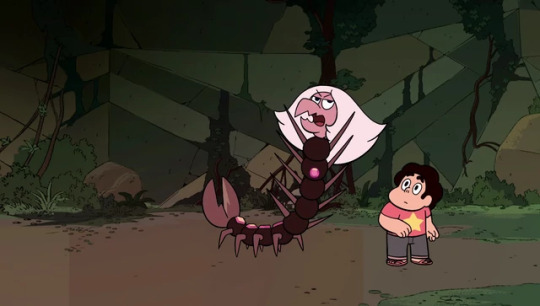
We also get a subtle premonition of Amethyst’s imminent focus, as she’s twice admonished by Pearl for making fun of Nephrite even though she’s not making fun of Nephrite either time. The feuding days of Amethyst and Pearl are long over, but there’s still a power dynamic between them that Monster Reunion quietly reignites. And Garnet is still in charge, ordering Amethyst to poof Nephrite in a way that’s frankly a bit uncharacteristic. Maybe it’s because we haven’t seen an actual fight with the three Gems working as an unfused team since Catch and Release (heck, we haven’t seen a fight against a Corrupted Gem since the Slinker in Reformed, unless you count the big crab in Rising Tides, Crashing Skies), but it sounds strange for Garnet to give a direct attack command. Amethyst is shown here to be the lowest-ranking Crystal Gem, not counting Steven, and this means everything to the season’s final arc.
There are certain things I would’ve loved to see as a fan thirsty for information, namely an actual translation of Nephrite’s writings. But it’s not as if we don’t get the picture(s) from her "conversation” with Steven, and eleven minutes isn’t enough time to tell this story and inject worldbuilding through text. It’s frustrating to not have all the answers, and a common complaint of Steven as a character is his lack of follow-up questions, but in this case he clearly knows the gist, and there’s no reason to think he couldn’t have gotten Pearl to translate offscreen if he was still interested.
So I’m glad we instead got a searing character-centric story that hurts enough that I almost never watch this episode. It takes a while, and it nearly costs Steven everything, but thank goodness we finally get justice for Nephrite.
Future Vision!
Our next chapter in Nephrite’s story is Legs from Here to Homeworld, where we finally learn that she’s a nephrite, that her commander was a hessonite, and that Blue and Yellow Diamond might not have been as intentionally malicious as we thought despite the abominable consequences. It’s crazy how important Nephrite ends up being, essentially paving the way for the Diamonds to begin reforming through Steven wanting to cure her and other Corrupted Gems.
Steven’s desire to write “I’m sorry” in Gem Scribble as he looks at the image of three diamonds, with hindsight, seems to indicate some subconscious knowledge of his indirect culpability in Nephrite’s corruption. Or he doesn’t at all and it’s just a coincidence.

Nephrite uses a white crayon to depict the Corruption Song, indicating White Diamond’s greater responsibility, and ultimately White Diamond’s key role in healing the damage.
We’re the one, we’re the ONE! TWO! THREE! FOUR!
Monster Reunion isn’t an episode I love to watch, because I don’t love to watch depictions of unbearable anguish, but it’s still an episode I love. Like Cry For Help, its sheer quality makes up for my infrequent rewatching.
Top Fifteen
Steven and the Stevens
Hit the Diamond
Mirror Gem
Lion 3: Straight to Video
Alone Together
The Return
Jailbreak
The Answer
Sworn to the Sword
Rose’s Scabbard
Mr. Greg
Coach Steven
Giant Woman
Beach City Drift
Winter Forecast
Love ‘em
Laser Light Cannon
Bubble Buddies
Tiger Millionaire
Lion 2: The Movie
Rose’s Room
An Indirect Kiss
Ocean Gem
Space Race
Garnet’s Universe
Warp Tour
The Test
Future Vision
On the Run
Maximum Capacity
Marble Madness
Political Power
Full Disclosure
Joy Ride
Keeping It Together
We Need to Talk
Chille Tid
Cry for Help
Keystone Motel
Catch and Release
When It Rains
Back to the Barn
Steven’s Birthday
It Could’ve Been Great
Message Received
Log Date 7 15 2
Same Old World
The New Lars
Monster Reunion
Like ‘em
Gem Glow
Frybo
Arcade Mania
So Many Birthdays
Lars and the Cool Kids
Onion Trade
Steven the Sword Fighter
Beach Party
Monster Buddies
Keep Beach City Weird
Watermelon Steven
The Message
Open Book
Story for Steven
Shirt Club
Love Letters
Reformed
Rising Tides, Crashing Tides
Onion Friend
Historical Friction
Friend Ship
Nightmare Hospital
Too Far
Barn Mates
Steven Floats
Drop Beat Dad
Too Short to Ride
Restaurant Wars
Kiki’s Pizza Delivery Service
Enh
Cheeseburger Backpack
Together Breakfast
Cat Fingers
Serious Steven
Steven’s Lion
Joking Victim
Secret Team
Say Uncle
Super Watermelon Island
Gem Drill
No Thanks!
5. Horror Club
4. Fusion Cuisine
3. House Guest
2. Sadie’s Song
1. Island Adventure
(No official promo art, but artist Jonathan Traynor's haunting sketch does just fine.)
26 notes
·
View notes
Text
Stupidly long Star Trek post, my apologies
So, as a long time Trek fan whose been watching Star Trek Discovery since its debut, and a recent binge watcher of Seth McFarlene’s Trek homage The Orville, I’ve come to a conclusion.
Star Trek shouldn’t be serialized.
Let me explain. First, let’s define some stuff. A serialized television show is one where each individual episode is a part of a larger story, and a viewer cannot grasp that story without watching the entire season, in order. Now, this type of show can have short arc side plots, but they all tend to be related to the main story as well. Star Trek Discovery uses such a format: each episode builds into the story of the war with the Klingons, and side plots like the Ash/Voq arc, or the Mirror Universe still serve this ultimate storyline.
In contrast, an episodic show is one where each episode tells its own self-contained story, where a viewer could tune into one episode and grasp that entire plot by the end. These shows can also have season long or series long themes, but they do not tend to ‘drive’ the series. The Orville (as well as TOS, TNG and the other Star Trek shows) follows this format; each episode tells a complete story, and the season has themes/storylines that continue throughout, like the antagonism with the Krill (the shows Klingon analogues) and Mercer and Grayson’s relationship.
Now, why do I think that serialization is a bad fit for a Star Trek show? Well, let’s try to pin down what Star Trek is about. The shows have obviously had different themes over the years, but the two most famous, successful shows (The Original Series and The Next Generation, and the others as well, but especially these two) were at their core a space adventure series following a small cast of characters we liked and related to, that used aliens and sci-fi as a metaphor for real life ethical and moral scenarios to tell engaging, fun and sometimes challenging stories.
So, with that premise in mind, why do I think episodic story telling is the best way to tell that particular type of story?
Because it gives us time to tell that story.
Comparing The Orville and Star Trek Discovery (which I think is fair, as they are both modern takes on the classic Star Trek formula), I’d argue that The Orville manages to tell a better Star Trek story, because it’s allowed to take the time to do so. The Orville has time to, for example, dedicate a whole episode to their third officer Bortus (the Worf analogue), and his same sex mate, and their struggle over whether or not they should perform a sex change on their female child (they are members of an all-male race where females are only born once every 75 years). That episode explores the themes of gender equality, and understanding cultures not your own, but is also a very personal episode where we get to look at Bortus’s culture, relationship, gender ideals and how the crew relates to this issue, and Bortus in turn. Or, as another example, The Orville has time to dedicate a whole episode to security chief Alara (the shows Vulcan analogue, at least physically) and her self-doubt and fear after she was unable to save a redshirt from a fire. We get to meet her parents in that episode, get an impression on how they view her career, and learn the fears of the crew in that episode, while also enjoying a horror comedy episode where Alara eventually triumphs, and learns to believe in herself.
Those episodes, and many more – like the one where Data analogue robot Isaac has to survive a post apocalyptic planet of cannibals while defending and bonding with the ships doctor and her children – serve to make the main cast feel real, and very well developed. I could genuinely tell you where Bortus and his mate went on their first date, or that Mercer views Kermit the Frog as an ideal leader, that LaMarr is afraid of clowns, or that Malloy loves pulling practical jokes. And that’s because the show doesn’t have to serve this overarching narrative, so it has the time to give each character fears and flaws and hopes.
Star Trek Discovery, on the other hand, doesn’t have that time. Each episode needs to build into the main narrative on the war with the Klingon’s and Burnham’s role in it that it doesn’t have the ability to dedicate as much time to the supporting characters. A prime recent example of this is the death of the show’s medic, Hugh Culber. His partner, Paul Stammets learns of his death, wakes up from his coma and then…immediately has a plan to get them out of the Mirror Universe. The next episode then is dealing with the war, their time jump and Mirror!Georgiou and Burnham, and while Stammets gets a scene about his feelings, the show can’t take the time to give them some room to breathe. To dedicate a whole episode just to that emotion and let us feel it with Stammets, because the main plot is too important to the story to just put it on the backburner. This leaves the personal aspect of the show - the crew, their relationships with each other – weak…unless they are relating to Burnham.
See, serialized shows do work in many cases. Marvel’s tv line up, especially Jessica Jones, are great examples of this. Personalized dramas, telling one main protagonists story are an amazing fit for serialization, as each episode builds into that character’s personal journey. Large ensembles stories are another: Game of Thones is serialized, but it has so many plot lines that it often feels episodic, where you can sideline one plot for several episodes and then pick it up again (this is, I think, a part of why fans aren’t enjoying the last season as much, as the rapid cutting down of plotlines has turned the show into direct serialization following only Cersei, Jon and Dany).
Star Trek Discovery, as a necessity of the format, has turned the show into a more personalized story about Burnham. And so, while Burnham and her story are developed, the side characters often fall by the wayside, or are only allowed rare moments to develop as characters not related to Burnham and her arc. I couldn’t even tell you the names of any of the bridge crew off the top of my head on Discovery other than Saru, much less any of their fears or ambitions. Now, this doesn’t make Star Trek Discovery a bad story…but I’d argue it doesn’t make it a great Star Trek story.
The universe of Star Trek Discovery feels small: less about exploring brave new worlds and meeting exciting new cultures, but about the personal, dark internal trauma of war. And you can say that well, the old Star Trek formula was tired and worn out and we needed to try something new…but The Orville proves that honestly, it wasn’t.
I think episodic shows get a bad rap as ‘lesser, pulpy’ media. The serialized personal drama of a show like Hannibal is always going to be critically more acclaimed than the episodic NCIS, CSI and a hundred other crime procedurals in their 10th and 15th seasons…but I’d be hard pressed to say that made Hannibal a ‘better’ show than those others. I’m just as likely to get as much enjoyment out of throwing on an episode of early seasons Criminal Minds as I am one of Hannibal (which I did enjoy). And to me, Star Trek Discovery (originally conceived and produced by Bryan Fuller, the guy behind Hannibal) feels like a show that’s a little bit ashamed of the campy, episodic past of Star Trek, and is pushing back hard on serialization and dark, violent war because it feels like it has something to prove.
Now, again, I’m not saying that The Orville is a better overall show than Star Trek Discovery (though I enjoyed it more, to be frank), or that Discovery is a bad show. All I’m saying is…I feel like we shouldn’t treat episodic shows as lesser to serialization, and that we should be able to accept that some genres and stories just lend themselves better to one format. Fun, utopian space adventures are a better fit for episodic storytelling, and darker, personal stories to serialization, and it just seems strange to me that the branded Star Trek show is the one falling in the latter category rather than the former. I think Discovery would benefit if it wasn’t a Star Trek story (with all of the unnecessary Star Trek cameos and tie-ins, like Sarek or Harry Mudd), but rather it was just a personalized space drama about a mutineer and a war, and it was allowed to stand up and be its own thing, rather than having to try and fit itself into a canon and universe it never quite seems comfortable in.
#star trek spoilers#star trek discourse#star trek discovery#paul stamets#hugh culber#seth mcfarlane#the orville#meta#critical analysis#essay#serialized fiction#serialization#episodic story#star trek#bryan fuller#michael burnham#captain ed mercer#kelly grayson#bortus#alara kitan#space adventure#the orville spoilers#captain saru#gays in space
170 notes
·
View notes
Text
Doctor Who’s Best Comfort-Viewing Episodes
https://ift.tt/2UgJy48
I mean, it’s not like absolutely everything is terrible right now, but certainly a lot of things are and we could all do with a break. As a result, here’s a list of Doctor Who stories – one chosen per Doctor – that I put on for comfort. Sometimes you need something familiar and well-worn to unwind with.
This list is very much subjective, some of it is down to which Doctor Who videos I could afford when I was 10. These stories work for me and it’s unlikely they will work completely for someone else. Also worth mentioning is that this list is incomplete; these are not the only stories I watch for comfort, and indeed sometimes that’s not the reason I watch these stories.
First Doctor: ‘The Aztecs’
‘The Aztecs’ is a great example of Doctor Who that can be both familiar, endearing and brutal. In this story Barbara is mistaken for the goddess Yetaxa, and attempts to use her influence to stop the practice of human sacrifice. The Doctor rails against changing history, the High Priest plots to reveal Barbara’s ploy. To escape, Ian has to fight to the death, Susan has to avoid an arranged marriage, and the Doctor has to pretend to romance an Aztec woman who might have the key to letting them reach the TARDIS again. It’s all very morally murky yet comes away feeling generous.
A lot of the characters are flawed and interesting. You understand their motives even if you don’t agree with them. The original TARDIS crew, who have hit their stride now, are included in this. The Aztecs are shown to both practice human sacrifice and meet writer John Lucarotti’s description of ‘a highly civilised and cultured race’.
It’s also a well-made show, and if anything the improved picture quality has been cruel to Barry Newberry’s backdrops – not for lack of detail, but for picking out the folds in the material. With the script doing the same for the characters, ‘The Aztecs’ shows us that comforting does not have to equal light.
Second Doctor: ‘The Macra Terror’
There’s something counterintuitive about choosing a Troughton story with almost no existing pictures because so much of his performance is visual. However, having first experienced a lot of Troughton stories as audio there’s still a lot to admire in his expressive vocal performance.
Also something potentially counterintuitive here is that I’m picking a story outside of the Base Under Siege format that dominated Season 5, which for many people is their platonic ideal of Doctor Who. However I feel that this does a great disservice to a subgenre I’m going to call ‘Weird Troughton’, defined by being an outlier from the series format or featuring Troughton still working out the role (so ‘The Highlanders’, despite being a historical with no science-fiction elements, counts because Troughton is still trying out strange and fun things with the character). ‘The Underwater Menace’ is ridiculous and I love it anyway, David Whittaker very much ploughs his own furrow, and ‘The Mind Robber’ raises the possibility that Doctor Who is a self-aware entity. ‘The Macra Terror’, now available as an animation, is for me one of the best pieces of drama produced from this group, managing to be sinister, fun and have giant crab monsters in it.
It’s an angry take on uniformity, jingoism and control and feels very current. The Second Doctor’s response to having his clothes cleaned and hair combed in accordance with colony beauty standards is great. Ben’s brainwashing gives Michael Craze a chance to show his range, and by choosing not to play it in a zombie or fugue state it’s all the more chilling. Plus, and I can’t stress this enough, giant crabs.
Third Doctor: ‘The Sea Devils’
‘The Sea Devils’ is a sequel to ‘The Silurians’, Malcolm Hulke’s story of prehistoric lizard people who were the dominant species on Earth before humanity. That story was a more considered, intense tale, whereas this is more of a romp with depth. With aquatic lizards instead of underground ones, it also features the Navy rather than UNIT, and the Navy is credited with assisting the production.
Possibly because of this collaboration Jon Pertwee (formerly of the Naval Intelligence Division during World War Two) is clearly having a great time. Otherwise the tropes of the era (the Master, the military, meddling civil servants, Jo Grant gets to be resourceful and plucky, six episodes that could have been done in four) are all present and correct and ready to be argued at. It’s extremely comfortable, and directed with pace and energy by Michael E. Briant (he also knows when to slow down: the submarine attack, for example, where the sailors arm themselves and get into position, watching in horror and confusion as the door melts in front of them).
Hulke injects just enough detail into the characters to bring them to life, with the cast rising to the challenge. Colonel Trenchard, for example, feels like someone you could hear at a golf club complaining about immigration. The final two episodes dispense with any notion of depth and instead we get a big ol’ fight scene where the Navy gets to show off its machinery and the stunt team gets to show off its flips and falls.
This story also features an experimental synth score and a swordfight between the Doctor and the Master where one of them stops for sandwiches. The Pertwee era is pitched incredibly astutely. Sure, it’s absolute nonsense, but it’s amiable nonsense with teeth.
Fourth Doctor: ‘The Ribos Operation’
‘The Ribos Operation’ (or, as it should be known ‘The Best Fourth Doctor Story’) kicks off The Key to Time arc by systematically undermining the entire concept. The Doctor is given a mission by the White Guardian (ostensibly nicer than the Black Guardian but with a hint of unease to him), to find six pieces of The Key to Time and restore balance to the universe. The Doctor is given a new companion, a recent Time Lord academy graduate with all the book knowledge but no experience of the universe.
Robert Holmes’ script is layered, funny, and treads a perfect balance between anger and (unexpectedly) kindness. It hides its subtleties with engaging dialogue and characters, all played with the right levels of bombast. And such characters! Garron and Unstoffe, one of several Doctor analogues (he’s a big, booming and charismatic conman, with Unstoffe as his game but questioning companion who brings compassion that Garron can’t) are rightly regarded as the standouts, but it’s also worth noting the Graff Vynda K: a villain of the piece, a prissy warlord full of self-importance but never heard of before or since, a backwater despot bullying his way across a tiny corner of the universe. The Doctor’s solution to a vainglorious, self-mythologising monster? To blow him up. An interesting response on a number of levels.
There’s nothing wrong with this story. It’s superbly constructed and well-made. It’s a perfect anti-epic, and the only story I’ve rewatched on DVD as often as I did VHS.
Fifth Doctor: ‘Enlightenment’
A wondrous peak in Eighties Doctor Who, starting as a cerebral science-fiction adventure before morphing into a cerebral science-fiction adventure that’s camp as tits.
You may recall Craig Ferguson’s description of Doctor Who as ‘the triumph of intellect and romance over brute force and cynicism’. ‘Enlightenment’ is a great example of this, with the romantic image of seafaring ships sailing through space corrupted by both the aloof officers and the Black Guardian’s influence. The Guardians here are ostensibly still representations of order and chaos, but mostly they’re ‘nice old man with bird on head’ and ‘ridiculous hyuk hyuking villain with bird on head’. The officer class are made up of Eternals – a race of godlike immortal beings who created this space race for entertainment – a great concept invented by writer Barbara Clegg after witnessing her rich relatives interact with her poorer ones at a family gathering.
The Doctor, through his intellect and faith in his companion, removes the corrupting forces. It’s not clear what happens to the surviving ships after the race is finished, but imagine finding one abandoned in space. It’s such a strong image in a story full of them. Clegg’s writing is full of great concepts and characterisation, including some excellent work with the regulars that makes them feel much more like real people than usual.
Read more
TV
How Doctor Who Was Quietly Revolutionised By Its Least Popular Season
By Andrew Blair
TV
Doctor Who Series 13: Jodie Whittaker Leaving Rumours, the Next Doctor, and the Future
By Jamie Andrew
Sixth Doctor: ‘The Mark of the Rani’
In which Time Lady the Rani experiments in a north-eastern mining town, causing violence to erupt.
First of all there’s the score, which is still of its time but feels distinctive due to its more tranquil ambient feel. It doesn’t sound dissimilar to The Microgram, someone who travels round the North East of England recording ambient noises and playing synths over them. There’s even one recorded at Beamish, which completes the loop here.
‘The Mark of the Rani’ is set in Killingworth, north of Newcastle, and technically so are the accents. They sound like someone went round RADA asking ‘Has anyone heard the song “Let’s Get Ready to Rumble” by PJ and *checks notes* Duncan?’
This slightly askew version of reality fits Pip and Jane Baker’s version of Doctor Who. Their debut script for the show establishes their style of endearingly serious batshit nonsense (landmines that turn people into plants, leading to the immortal line ‘The tree won’t harm you’). It’s like their stories are written by Wallace with minimal input from Gromit.
As a result ‘Mark of the Rani’ stands out amidst the aggressive stories surrounding it. It can be taken as merely enjoyably daft, but it’s also got some substance to it. Pip and Jane clearly remember Doctor Who as being the kind of show where the Doctor and his companion got on, so Peri is subjected to less arguing and is even defended (admittedly in terms of utility) by the Doctor.
The Rani is actually a character here, as opposed to her other appearances where she is simply A Villain In Doctor Who, and her presence immediately reduces Anthony Ainley’s Master to a supporting comic relief character. This suits him. When you’re standing in a field caked in shit pretending to be a scarecrow and laughing at passers-by for not noticing you clearly we can’t take you seriously anymore, so at least this story doesn’t pretend he’s a credible threat.
So on the one hand it’s daft, silly fun, but on the other it’s a mid-Eighties story featuring a chemist torturing Northern miners for her own gain. Guess what degree Margaret Thatcher graduated from Oxford with?
Speaking of Thatcher:
Seventh Doctor: ‘The Happiness Patrol’
Within Doctor Who fandom, no one has ever said ‘Oh you don’t like the McCoy era? I’m sorry, you never mentioned it’, and ‘The Happiness Patrol’ revels in all the things its detractors hate about the era. It’s intentionally camp and uses symbolism rather than demanding to be taken literally, like a more confident version of Season 24. The Kandy Man is rightly noted as (visually) a Bertie Bassett parody, played as the ludicrous creature he undoubtedly is.
Knowing that it is restricted in what it can show in terms of violence, the show had now worked out how to be ostensibly child-friendly and incredibly morbid, hence the screeching sweetie-creature, the Day-Glo ray-guns, and the guy who gets drowned in a vat of jam. When you’re three and have never seen Doctor Who before the Kandy Man is downright terrifying, this bizarre monster who twists and turns and screams. This was my first experience of Doctor Who and, appropriately enough, it scared the hell out of me.
As an adult, I find it’s a pleasing return to the ‘Weird Troughton’ stories of the Sixties, the ones where the Doctor was an unassuming but powerful anarchic figure. Here we have a variation of this, where the Doctor has been trying to explore the universe but finds it full of monsters, and starts doing something about it.
Before Season 26 attempted something approaching realism, this story suits Ace and the Seventh Doctor who both feel like Children’s TV archetypes who have grown tired of their roles. Ace’s CBBC leanings (with crap swearing and Blue Peter badges) fits into this heightened reality better than she does a less tonally certain story (like ‘Battlefield’). ‘The Happiness Patrol’ feels like a combination of the different approaches of the McCoy era, a best of album with a life of its own.
Eighth Doctor: ‘Night of the Doctor’
This is specifically because of the circumstances of broadcast, although it’s also a melancholy meta-commentary on the show’s cancellation and wilderness years in which Paul McGann gets to demand ‘Bring me knitting’.
It’s not merely the return of McGann to the onscreen role of the Eighth Doctor after 17 years, it’s that this was kept a surprise until the mini-episode was released in the build-up to the 50th anniversary special. It was such a treat, and I still remember the email I sent to the site’s TV editor when I watched it for Den of Geek. It read ‘OH MY F***ING GOD’ and was sent while the episode was paused just after the word ‘expecting’.
And so I told my friends. I know people watched this in work meetings on their phones under the table. It’s associated with a lot of feelings, not least building excitement. This one is connected very clearly to a moment of shared joy.
Ninth Doctor: ‘The End of the World’
While ‘Rose’ is rightly adulated as bringing Doctor Who back to a large prime time audience, ‘The End of the World’ had a different job to do. Viewing figures went down for this episode after over 10 million people watched the series opener, but went up again after this, suggesting positive word of mouth from this episode, consolidating the success of ‘Rose’.
The production team were aiming to use this episode to show off how Doctor Who could look in 2005, with hundreds of CGI shots and dozens of aliens gathered together. It also showed the new Doctor’s emotional distance, in that his idea of showing off to his new companion is to take her to see her planet getting destroyed.
We also get, in a late addition to the script, Russell T. Davies’ knack for making the alien familiar with the character of Raffalo (‘You’re a plumber?’) who is almost immediately killed, further demonstrating RTD’s knack for knowing which character’s death will have the most impact (and if you’ve not read his novelisation of ‘Rose’ you really should if just for Clive’s death in prose form. Honestly it’s incredible).
‘The End of the World’ is a comforting reminder of the nascent excitement surrounding the 2005 series, that feeling of turbulence that eventually settled because of the strength of these early episodes.
Tenth Doctor: ‘The Fires of Pompeii’
The episode itself has a soothsay-off between Metella and Lucius to set up a plot point and the series arc, and the first TARDIS trip for Donna as a full-time companion. You immediately get to see the strengths that Catherine Tate is going to bring to the series, not merely her comic and dramatic ability but the way Donna is able to stop the Tenth Doctor from his worst impulses, and by bluntly dismissing the notion of fixed points in history meaning just allowing bad things to happen. This is, for me, the best episode in the first half of Series 4 by a long way.
Sure, there’s a colossal death toll here which is far from comforting, but as ever nostalgia and context plays a huge part here. This was an episode broadcast on the night of our fan club’s night out, a phase of my fandom that turned me from someone who liked Doctor Who in primary school into an adult fan. This has, overall, been worth it. So what this story reminds me of is, following on from ‘The End of the World’s establishing the series, is the initial excitement and patterns of Russell T. Davies’ series where he set up some key words or phrases early on and fandom tried to work out their significance, resulting in the heady days of someone saying Norman Lovett was going to play Davros in ‘The Parting of the Ways’ on IMDb.
Eleventh Doctor: ‘A Christmas Carol’
Quite a few contenders here, but I’ve gone with my favourite Christmas Special because these episodes are often Doctor Who at its broadest, suitable for the half-cut who dwell in food-comas. This episode is one of the last of these stories, before the Christmas Specials became steeped in the main continuity of the series. It’s also a great example of the childlike impulsiveness of Matt Smith’s Doctor before he became more of a teenager in Series 6. It’s great fun and the riffing on Dickens lands really strongly for people like me, who often respond more to a strong realisation of an idea than they do pathos.
This story is designed to be comfortable and succeeds by establishing what a Steven Moffat Christmas Special will look like: lots of time-travel, obviously, but also a big budget version of ‘The Happiness Patrol’s daring the audience to find it too ridiculous. As a result we get a remix of A Christmas Carol featuring flying sharks pacified by a mezzo-soprano, with the joy of these disparate elements coming together through that most underrated of Moffat staples – a grumpy old man learning to let go while being dragged through the sky by animals who usually lack the power of flight.
Twelfth Doctor: ‘Mummy on the Orient Express’
With Capaldi realising his initially abrasive take on the character was too much, this story relieved the tension that had been building with the Doctor’s behaviour, allowing him to explain himself and setting up the arc that culminates in ‘Hell Bent’.
Once this was broadcast I breathed a sigh of relief. Despite wanting it not to be the case I’d had to reach for the positives in the Capaldi era thus far; with the exception of ‘Listen’ the stories had felt like treading water until ‘Kill the Moon’ split the room. Even if you don’t like it (and I mostly don’t) that was the first story that felt like it was trying something different and paved the way for the increased complexity of the Twelfth Doctor’s character. Ultimately what the show needed at this point was a run of good stories, and – appreciating some people don’t get on with ‘Forest of the Night’ (and I mostly do) – this was the start of a really strong run.
‘Mummy on the Orient Express’ is a mash up of concepts that Doctor Who excels at, with an enjoyably horrific Mummy and the actual countdown to its victims’ demises contributing to making each death count. This is harder than it looks, the balance between violence and pathos taking into account the family audience, but the combination of ideas really makes them land as brutal without gore. By putting the Doctor through this writer Jamie Mathieson manages to explain his apparent heartlessness as weariness at making tough choices, but being unable to resist getting into situations that require them. The path is now clear from here to the heights of ‘Hell Bent’ and ‘The Doctor Falls’.
Thirteenth Doctor: ‘It Takes You Away’
Obviously there are fewer Jodie Whittaker fewer stories to choose from, and for me it has to be one from Series 11 because that felt like a palette cleanser for an approach to Doctor Who that never manifested. For all its ups and downs, limiting continuity references and focus on new characters or threats felt like a good move. Certainly the guest writers all provided solid stories, and while the series didn’t soar for me it felt like a good platform to improve from, which is partly why Series 12 was so disappointing (it felt like it addressed problems that weren’t there, ignoring the ones that were).
cnx.cmd.push(function() { cnx({ playerId: "106e33c0-3911-473c-b599-b1426db57530", }).render("0270c398a82f44f49c23c16122516796"); });
‘It Takes You Away’ is frequently surprising, offering a simple blunt horror of loss (the childlike refrain of the title, the fear of absence) combined with endearingly outlandish performances by the actor Kevin Eldon and a sentient universe manifesting as a talking frog. It allowed Jodie Whittaker a rare success in negotiating her way out of a situation, and progressed the character arc of the series with Ryan and Graham’s changing relationship. It’s obviously imperfect (ideally, Hanne’s Dad’s manipulative behaviour would be properly addressed) but it’s also imaginative, moving, and weird, and these are three things I really want Doctor Who to be.
Share your go-to Doctor Who comfort viewing episodes below.
The post Doctor Who’s Best Comfort-Viewing Episodes appeared first on Den of Geek.
from Den of Geek https://ift.tt/3jv4sqO
0 notes
Text
Lust For Darkness Review (2018)
When I use the term ‘Erotic Horror Game’, it probably conjures in your mind one of those weird browser games with anime girls that have breasts the size of hot air balloons. Mercifully, Lust For Darkness isn’t that. What it is, is a walking tour through a grotesque and highly sexualised dimension. It focuses down on lust and brings it through to its natural conclusion. Which seems to mean a lot of penises and vaginas all over the place. And lots of death.
Lust For Darkness is certainly not for the easily embarrassed. In fact, the thing that I respect Lust For Darkness for most is that it didn’t hold back. There’s a lot of actual sex happening. No black borders or fuzzy screens here. Detailed penises everywhere. If they had censored it, I feel the major point of the game would have fizzled out. Mankind’s destructive libido makes less of an impact when it’s tucked behind a privacy border. Unfortunately, however, this central theme of lust is all Lust For Darkness can stand on. In making an interesting world, they’ve ensured we never do many interesting things in it.

Lust For Darkness starts the way many of these things seem to. We get a short prologue where a girl named Amanda wanders around what appears to be someone’s sex dungeon and something rather horrible happens to her. Cue her boyfriend, Jonathan, getting involved. He was busy minding his own business in his nice, safe home when a note gets slipped under his door and he’s off to Yelverton manor to rescue her. Once there, he finds a bunch of masked cultists talking about a ceremony and things quickly get out of hand.
Thus begins Lust For Darkness and it’s peculiar blend of stealth and running away. See, Lust For Darkness is rather hard to pin down because it keeps bringing in ideas and then immediately throwing them away. Case in point: the stealth. When you first get to Yelverton manor, without the mask or a robe which are a cultist’s proper uniform, you need to sneak past the guards. It’s a fairly easy thing to do, given their extremely limited vision cones, but it never really comes up again. Once you get hold of a mask, you pretty much never need to sneak.
When you’re inside the manor though, things pick up a little bit. Jonathan begins to unravel the threads of a Lovecraft soaked story about a bunch of cultists trying to buy their way into an Old God’s realm by having lots of crazy sex. As plots go, it’s certainly one of the more exciting. After poking around the manor for clues about Amanda, he walks downstairs to find everyone boning to the romantic tunes of Mozart’s Requiem. It’s an utterly bizarre moment and showcases what Lust For Darkness is good at: shocking you. And making sex scenes seem extremely creepy.

Once you tiptoe past the orgy that’s happening downstairs, you find a portal to a strange dimension called Lust’Ghaa. This is where the bulk of Lust For Darkness takes place. Lust’Ghaa is an odd place; deliberately unpleasant. You can picture the sort of thing. Walls that look oddly flesh like, weird sexual sculptures everywhere and lots of moaning. It’s a nice place. It’s a little overdone as far as otherworldly, hell-like places go but I did quite like it. It feels very crafted around the central idea of lust.
My problem with Lust’Ghaa is that we never really do much in it. There are a couple of good puzzles (I enjoyed one Geiger-esque one that involved rotating weird pipes) and a few chase scenes. These are exciting but brief, without much of a challenge to them. The rest is just wandering through it looking for the portal back to the manor, where the same thing happens there. You can just weigh down the analogue stick and be done in no time. I think that’s a problem in games where they focus solely on the world. I hear Agony got some similar shtick. The gameplay is always going to suffer because complex gameplay would stop you focusing on the world.
So it becomes like walking through a haunted funfair house. Albeit, a sexy one. What could set it apart is the story, but Lust for Darkness is wobbly on that too. The actual underpinnings of the story aren’t bad. Cultists are getting together to summon an old god, and open a portal to its domain, in a very sexy way. This inevitably goes wrong and some of the cultists want out. Honestly, some of the best bits are the cultists talking about what to do now that bodily fluids have hit the fan. As you progress through, the mansion begins to fall more under Lust’Ghaa’s influence and the cultists are brutally murdered.

Unfortunately, the story too keeps bringing up notes and then immediately dropping them. We’re told we’re a father at one point, which raises the stakes up higher. Then, about twenty minutes later, we’re told it’s not our kid and they’re way back down again. We also lose our mask at one point. Potentially a big problem, that’s quickly swept under the rug. It feels like Lust for Darkness knows how it wants to end and is trying to hurry you along, throwing you bits and pieces along the way. A shame then that the final boss fight is so absolutely horrible but at least the story closes on a high note.
It’s a short story, but in a way that I can respect. The developers stated that they didn’t want to add in anything superfluous; anything that would get in the way of the story. That’s understandable and perhaps goes some way to explain how bare bones it is. They wanted the focus to be on the world and they’ve done that. But that’s a double edged sword. Lust For Darkness is a vivid, perhaps unforgettable (for one reason or another) horror experience. As a horror game? Not so much.
Pros
-Lust’Ghaa is a visually interesting place
-It doesn’t censor itself
-Story has some interesting Lovecraftian notes
-A few good puzzles
Cons
-Gameplay generally is bare bones
-It’s rather short
-Brings up ideas and then drops them
-Final boss fight is a right pain in the arse
Lust For Darkness
Developer: Movie Games Lunarium
Release Date: 12th June 2018
Play it on: Windows
Played on: Windows
#Lust For Darkness#Agony#Games#Gaming#Horror#Survival Horror#Video Games#Article#review#tea and video games
1 note
·
View note
Photo

For the week of 30 April 2018
Quick Bits:
Avengers #1 represents the cyclical nature of comics. While the story continues on from Marvel Legacy and highlights themes of legacy heroes and returning hosts of Celestials, on a functional level it also represents a circling back to a kind of “status quo” of the Avengers big three. Similar to what happened during Marvel’s Heroic Age branding and Avengers Prime some eight or so years ago. Jason Aaron’s meta-commentary in the book, about the changes and return of the characters is certainly interesting.
That being said, it’s also a fun book. The art from Ed McGuinness, Mark Morales, and David Curiel is suitably bombastic. I particularly like the new designs for the Final Host, weird, but still within a similar enough Kirby aesthetic. It’s also nice to see the Million BC Avengers again.
| Published by Marvel

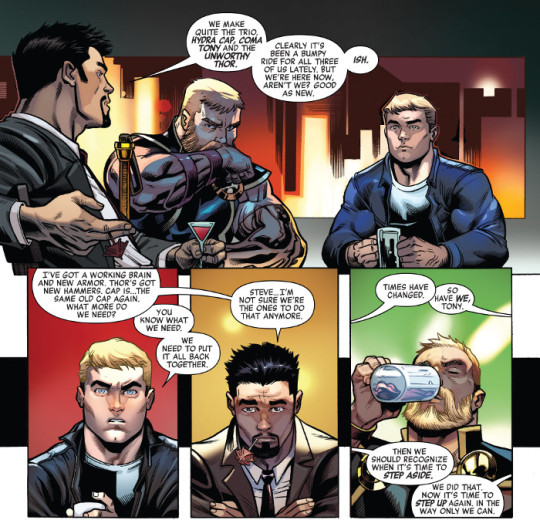

Black Science #35 returns from its most recent break with a bit of a mindfuck. Kind of par for the course. Rick Remender basically gives us “Saving the Eververse through Couples Therapy” and it encapsulates one of the larger themes in the series of the problems with family, the mistakes made, and the lengths people go to in order to try to make things right. As usual, Matteo Scalera and Moreno Dinisio makes it look gorgeous. I think Scalera can probably make anything look visually interesting at this point.
| Published by Image / Giant Generator



Breathless #2 steps up the action, with Scout and Grace-Eisley trying to fight their way out of the labs, only to discover that the appearance of the drinkers hints to a deeper conspiracy. The story Pat Shand and Renzo Rodriguez is telling is fairly good. I like the use of flashbacks to flesh out Scout a wee bit more, and the art from Rodriguez and colourist Mara Jayne Carpenter, particularly some of the layouts and character designs, is quite impressive.
| Published by Black Mask Studios



Captain America #701 starts Mark Waid’s end run on the series before it gets relaunched with Ta-Nehisi Coates guiding the ship. Again, Waid is playing with time and legacy here, with the story set in the 24th century, but with an eye to travelling through Cap’s history. It’s fairly captivating, with some great art by Leonardo Romero and Matthew Wilson on the main story and flashbacks from Adam Hughes and JG Jones & Paul Mounts.
| Published by Marvel



Coda #1 is an incredible debut from Si Spurrier and Matías Bergara. The fantasy world that Spurrier and Bergara have created here feels rich, deep, and sorrowful. Living in a world where it seems like evil won, stripped magic and hope from existence, and most of those who remain live by a kind of brutal and bleak lawlessness. Or cling to what our protagonist, “Sir Hum”, would consider useless grasps at the world gone by. It reminds me a bit of The Last Unicorn mixed with Mad Max, and it’s wonderful. Spurrier’s dark humour shines through and Bergara’s art (with colour assists from Michael Doig) is stunning.
| Published by BOOM! Studios

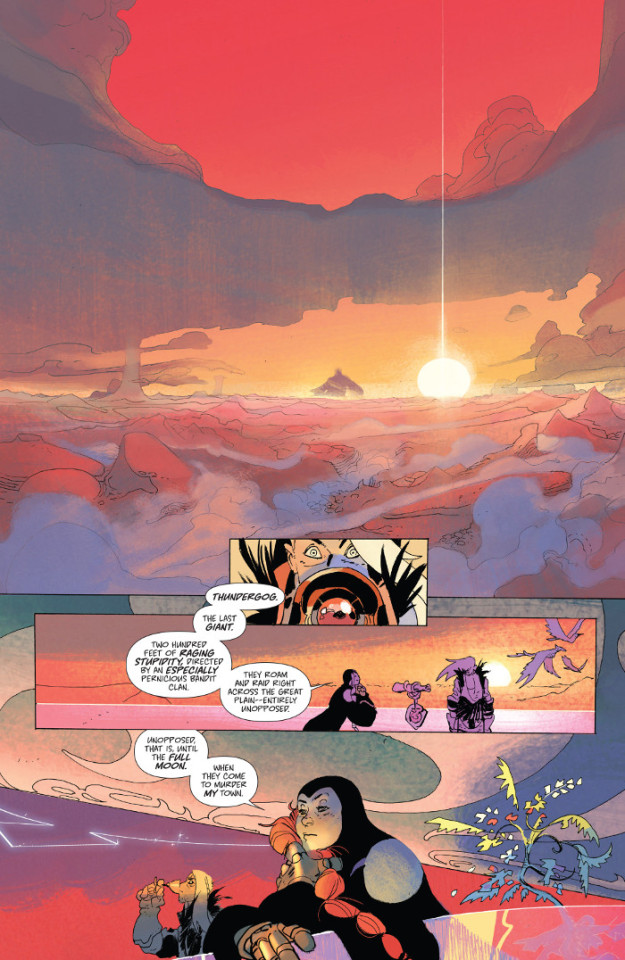

Come Into Me #2 hits a few technological, biological, ethical, and moral walls as they try to figure out how to excise a dead person’s mind from Sebastian’s body. Lonnie Nadler and Zac Thompson have something existentially frightening here, tapping into the kind of intellectual body horror that David Cronenberg is known for, beautifully illustrated by Piotr Kowalski and Niko Guardia.
| Published by Black Mask Studios



Dark Ark #6 begins a new arc, giving us flashbacks of Shae learning about Noah’s ark and the methods he uses to begin building his own. I like that Cullen Bunn is going back to fill us in on how the second ark came about.
| Published by AfterShock

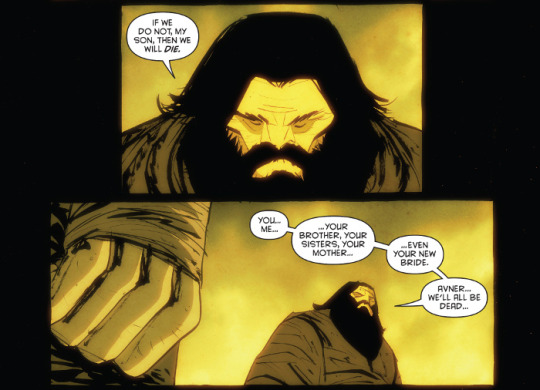

Death or Glory #1 is a beautiful comic. Bengal’s art, from character designs, page layouts, vehicles, composition, colour choice, and more is just amazing. Visually, this is a feast. The story too is captivating. The Last Days of American Crime taught us that Rick Remender can write a mean crime story and the start of this one is really not to be missed. Glory Owens is an interesting character, her reasons for turning to crime understandable, and the world that Remender and Bengal are creating seems to be deep and fascinatingly populated.
| Published by Image / Giant Generator



Doctor Star and the Kingdom of Lost Tomorrows #3 continues this excellent look at the possible real world ramifications of a Ted Knight Starman analogue missing out on the life of his wife and child. Jeff Lemire excels at family dynamics and this series has just been one gut punch after another.
| Published by Dark Horse

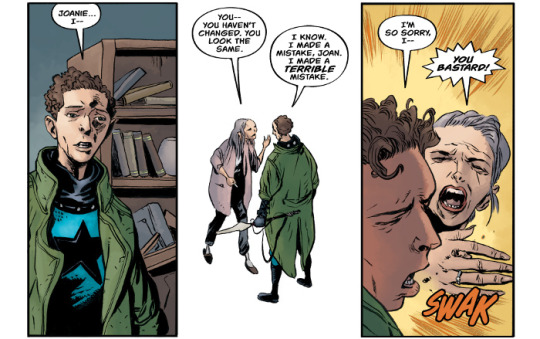

GI Joe: A Real American Hero #251 begins a new arc of largely single issue stories focusing on an individual Joe or member of Cobra. This first part spotlights Stalker and has some great art from Alex Sanchez and Ronda Pattison.
| Published by IDW



The Gravediggers Union #6 revels in its glorious madness with an epic confrontation between the Black Temple and the Gravediggers Union for the fate of existence. Toby Cypress and Niko Guardia do a great job portraying the action and insanity of the battle.
| Published by Image

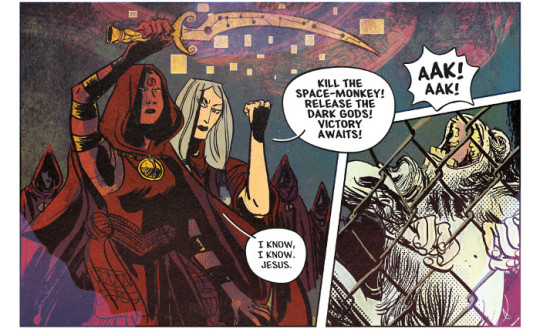

Harbinger Wars 2 Prelude #1 is pretty epic, even just as set up. This issue serves as a sequel to Eric Heisserer, Raúl Allén, and Patricia Martín’s excellent Secret Weapons mini-series, as well as the massacre of the Generation Zero kids in Harbinger Renegade last year, and the titular prelude to Harbinger Wars 2. It’s good. The American government has basically gone insane and have taken to trying to kill every psiot on Earth, so Livewire does something drastic. It’s huge.
| Published by Valiant



Hunt for Wolverine: Weapon Lost #1 is the first of the four mini-series with groups looking for Logan. It’s also the one with the most tenuous of reasons for existing, given that Kitty went to Daredevil because Multiple Man is dead (at least until the summer) and they don’t have any other detectives. Ignoring, of course, the whole load of psychics they could use, hunters and trackers like the Weapon X group, mutant trackers like Prestige and Caliban, Agent X, hell...even Deadpool. This is more just the group of people that Charles Soule wanted to write, even if the remit’s ridiculous. Regardless of the in-story or meta reason for coming together, this isn’t bad. Soule’s set up here is mostly a gathering of the group, giving us a look into the previous cop life of both Frank McGee and Misty Knight, before leading us to a welcome return of the final member of the team. It also looks damn good with art by Matteo Buffagni and Jim Charalampidis.
| Published by Marvel

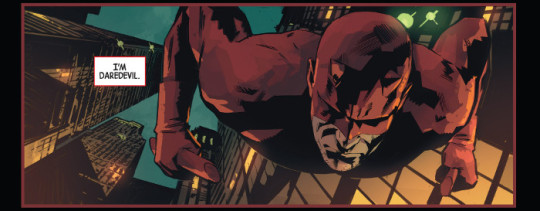

Infinity Countdown #3 advances the overall story a bit, giving us an underlying mystery as to characters coming to an understanding that reality has changed since Infinity. How, why, and what remain unknown, but it’s an interesting tidbit. Also, the conclusion of the battle over the power stone is absolutely ridiculous, it needs to be seen.
| Published by Marvel



Koshchei the Deathless #5 details the twist in the tale where Koshchei became a slave to Baba Yaga. It’s interesting how Mike Mignola dovetails Koshchei’s story with events and characters through Hellboy and BPRD history. And how horrible Baba Yaga was in her thirst for revenge.
| Published by Dark Horse

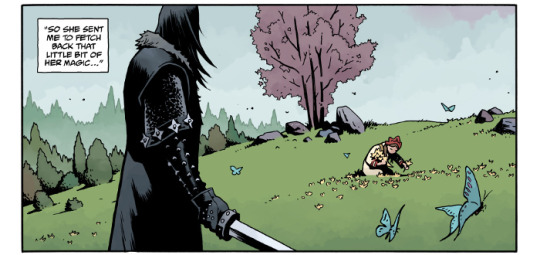

Red Sonja/Tarzan #1 is likely to make a lot of people angry. Not because it’s bad, not because it’s controversial, or anything like that. It’s because Gail Simone has created a villain in Eson Duul, an arrogant bully and poacher, that is so despicable, so cruel, so heartless, that you’ll likely want to punch him yourself. It’s interesting to see both Red Sonja and Tarzan at such a disadvantage.
| Published by Dynamite

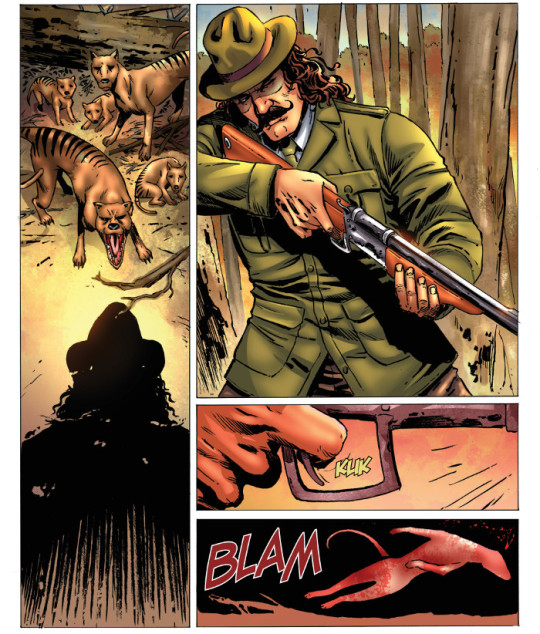

Rogue & Gambit #5 is only partially a conclusion to the series. Sure, Kelly Thompson brings to a close the bizarre mutant stealing couples retreat arc and gives a sense of closure and reconciliation in Rogue and Gambit’s relationship, but she leaves open the door for more. Especially with questions about the series’ villain, Lavish, left up in the air. I certainly hope to see this plot thread picked up on. Also, the art from Pere Pérez and Frank D’Armata is gorgeous.
| Published by Marvel



Scales & Scoundrels #9 is a largely silent issue with Lu coming across a man who’s lost his voice, a lonely siren, and a hunt for treasure at the bottom of the ocean. This issue’s storytelling rests largely upon Galaad’s ability to portray everything visually and it pays off in spades. The art is beautiful and story flows incredibly, with the silence adding a necessary depth to the fable that Galaad and Sebastian Girner are telling here. Great work. If you haven’t picked up this series before, this is a wonderful single issue story to jump in with.
| Published by Image

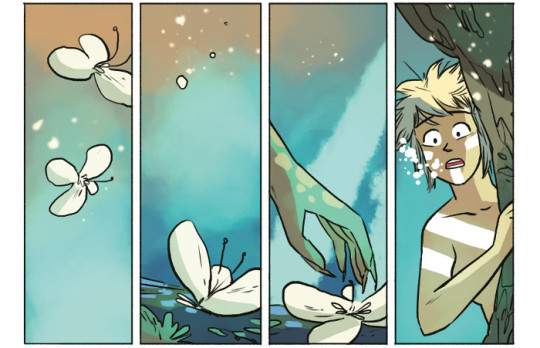

Sherlock Holmes: The Vanishing Man #1 is off to a good start with a new mystery from Leah Moore and John Reppion. I really like Julius Ohta’s style. It’s somewhat similar to Cully Hamner and Adam Pollina and it adds to a pretty nice looking book.
| Published by Dynamite



Spawn #285 is another issue made so much more by the art from Jason Shawn Alexander and Lee Loughridge. The series has stepped back from the oblique horror with this arc with Todd McFarlane resuming writing duties, opting for the more familiar government and military conspiracies that have been part of the series since the beginning, but it’s entertaining.
| Published by Image

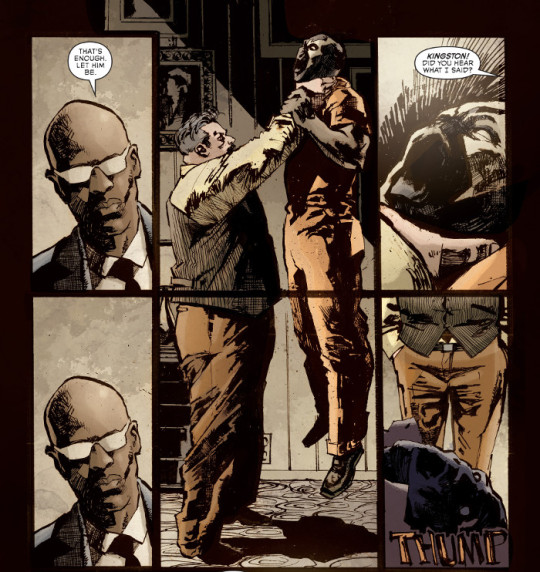

Spider-Man #240 is the second-to-last stop on the Bendis Farewell Tour, but this one feels like the big goodbye. Partially because of the long heartfelt letter from Bendis at the end of the issue, reminiscing about his years of work on Ultimate Spider-Man and all of the wonderful people he collaborated with over the span. And because this really is the end of nearly two decades’ worth of work, first with Ultimate Peter and then with Miles Morales. This conclusion is more personal, evidenced largely due to the story structure itself, being an issue of reflection and recuperation.
| Published by Marvel

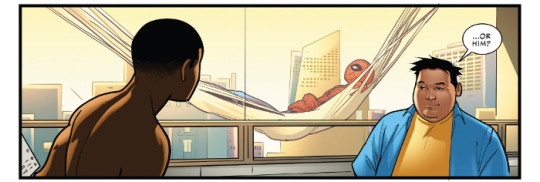

Star Trek: The Next Generation - Through the Mirror #1 continues on from the recent Mirror Broken series, bringing the main timeline crew into the mix. This issue is split into two stories, a lead one with art by Marcus To and Brittany Peer in the main timeline and a back-up in the mirror universe with art by J.K. Woodward. The art throughout is great.
| Published by IDW



Transformers vs. Visionaries #5 ends the series in a pretty spectacular fashion as plots and machinations come to fruition. Wonderful art from Fico Ossio and David Garcia Cruz. It’s just a shame that we won’t really be getting more of the Visionaries with the line ending soon, because Magdalene Visaggio gave us an interesting starting point here for a new wrinkle on Cybertron.
| Published by IDW

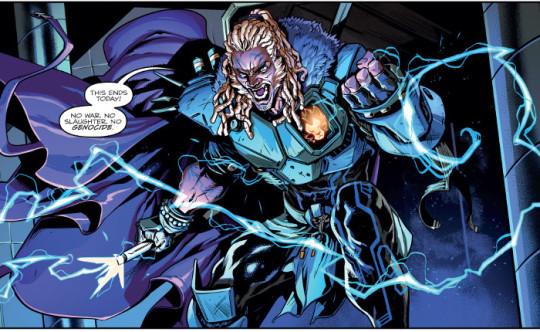

Venomized #5 brings Cullen Bunn’s Poison trilogy to an end in a rather interesting fashion that gets to spotlight the Monsters Unleashed monsters and give a bit of closure and justice for the original five X-Men who were pretty badly beaten up in the centre act. Iban Coello also really gets to cut loose on the art in this issue as well, elevating his work even higher than before with some of the sequences.
What this series unfortunately also highlights, like the new Avengers, is the current mishmash of timing with Marvel’s continuity. This has to be after the current X-Men Blue arc because the X-Men are back on Earth, but before the recent Mighty Thor arc because of Lady Thor, and...undoubtedly other things you could point out that would probably seem like nitpicking. It kind of feels like some things in the “Fresh Start” are necessitating things to be rushed in places. So, in terms of continuity, this is a bit of a mess.
Still, taken on its own terms, without trying to figure out how it works in the broader shared universe, this has been fun.
| Published by Marvel



Weapon X #17 begins the process of the characters wondering why this team still exists, as the status quo is shaken by Sabretooth taking lead of the team while Logan recovers from the last two issues’ birthday brawl. It feels like the beginning of the end, but Greg Pak and Fred Van Lente are still making the story fun.
| Published by Marvel

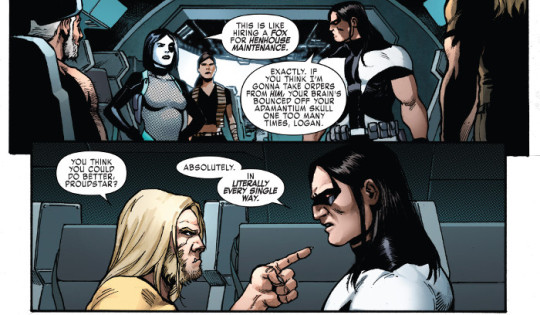

Other Highlights: Astonishing X-Men #11, Avengers: Back to Basics #5, Black Science #35, East of West #37, Giant Days #38, Go Go Power Rangers #9, Jazz Maynard #10, Maxwell’s Demons #3, October Faction: Supernatural Dreams #3, Red Sonja #15, Rick Veitch’s The One #3, Sex Criminals #24, Star Wars #47, Xerxes #2, You Are Deadpool #1
Recommended Collections: Archie - Volume 5, Reborn, Extremity - Volume 2, The Gravediggers Union - Volume 1, Scarlett’s Strike Force - Volume 1, She-Hulk - Volume 3: Jen Walters Must Die, Star Trek: Boldly Go - Volume 3, Stray Bullets: Sunshine & Roses - Volume 1, Young Terrorists

d. emerson eddy knows who put the dog in the dog house.
3 notes
·
View notes
Note
This may sound like a weird question, but if Yellow Diamond and Steven do interact, how do you think it would go? And a weirder question. how do you think a Yellow Diamond and Connie interaction would go; for some reason, I don't know why I am interested in the latter, but I am, you know?
I’ll focus for now on YD and Steven, mostly because I feel like the main avenue YD would acknowledge Connie and seriously pay attention to her at this point in the game is either through Steven or through the other Crystal Gems- most directly, through Rose because Connie is literally taking up Rose’s sword- and I think Connie would deserve better than that. Also because my thoughts on Steven and YD interacting ran long.
I feel like if YD goes into the interaction knowing about Steven’s gem, and knowing he’s either Rose’s son, or, under the assumption he is Rose- she’s going to be deeply conflicted.
On the one hand: this is everything she’s been trying her absolute hardest to not think about. Everything uncomfortable about Earth, about the war, about loss, really comes right back to Rose.
On the other hand, YD is too smart for the inconsistencies not to add up. She’s a scientist, a researcher, and kind of a perfectionist. She wants to box things neatly, and clearly label them- sort what’s important and what isn’t. Her pride hinges on it, but it’s also her main means of relating to the world.
And Steven doesn’t box easily. He’s very much something new and unusual.
Considering YD as a character who’s going to develop, and a character who we’re going to explore- we’ve already seen her confronted with that kind of dilemma (confront the scary thing and gain new information vs. reject new information, but avoid the scary thing) and choose avoidance over knowledge in Message Received- it would both further explore YD as a complicated character, and serve the plot narratively, if at least tentatively, YD’s decision with Steven is geared more towards confrontation than avoidance.
Because that will require her giving Steven, at least in some manner, a platform to speak on. It’ll require her paying attention to him.
One of the main themes of SU is catharsis, in terms of how you only heal from bad feelings by letting them out. Crying Breakfast Friends isn’t just a joke on how much people cry in this show- the main times we’ve seen in-universe plots, the character cry as a resolution to conflict. Amethyst is weirded out because “why would you want to watch something about crying?” but overwhelmingly what we see, the universe of CBF is actually rather happy. In Cry For Help and the Steven Reacts short it seems to overwhelmingly have a cast that cares about each other, and wants to support each other. The introduction of antagonistic figures in a play-by-play parallel of The Return culminates in a negation of conflict and compromise specifically centered on the Jasper-analogue character (and people still think there won’t be a Jasper redemption….)
I stand firmly by the fact that Yellow Diamond is not evil. She’s done a lot of harm, and she is responsible for her actions. But it’s worth mentioning that thematically, YD occupies the role expected of the main villain. She’s Steven’s counterpart on Homeworld- not the only authority, but the main one, and the one who seems the most personally dedicated to trying to keep things running.
So what’s interesting? YD is staunchly anti-catharsis. Her only song so far is literally titled “What’s The Use Of Feeling?” and shows her trying to stifle her own emotions while encouraging Blue to do the same. She’s positively miserable- it’s damaged her job, her relationships with others, her emotional health, everything- but she is trying to respond by forcing down further and further on feeling nothing. The logic of the show, over and over again, is telling us YD won’t get anywhere until she allows herself to feel bad. Until she actually lets those feelings come out.
Steven is in the role of the main hero. This means that narratively, he’s matched against YD. And as the hero of this story, Steven is, at his most triumphant moments, the champion of the show’s morals: among them, catharsis. Part of this is that Steven’s drive to understand people often leads to him picking at and dredging up conflicts and feelings in their past (consider Horror Club, the initial falling out between Lars and Ronaldo would never have come to light, not LG herself been revealed, if Steven hadn’t been the main catalyst in bringing Lars to the lighthouse. He did it obliviously, but it still happened)
YD engaging Steven is going to challenge YD on the battleground of her own feelings and her desire to bury them. She’s going to have to confront Steven because he’s dangerous, because he’s a threat, because YD leaves herself no room to feel in her duty- for the good of all Homeworld, she has to face this new leader figure of the Crystal Gems or risk losing everything she’s worked for. And that confrontation means we’re going to see more things slipping through the cracks the way it did at the end of “What’s The Use Of Feeling, Blue?”
That whole interaction in That Will Be All between her and Blue gives us, I think, the main conflict in YD that Steven will be able to exploit to get past her determination to avoid Earth. Because as much as YD doesn’t want to talk about Pink, doesn’t want to talk about Earth- if she thinks it’s her duty, even if nobody else is actively telling her to go and do this, YD’s sense of responsibility will override her sense of avoidance, seemingly, every time. Now, this sets her up in an awful place because as we see in Message Received, YD’s determination to hear out Peridot’s report even though it was beneath her set her up in an awful place.
Basically, YD should not have been making that judgment call. She knows she’s an emotional mess when it comes to Earth. She’s too biased to possibly be an effective jury. Peridot calls her out on not being objective and YD has no rebuttal besides “It doesn’t matter, I’m in charge!” which is weak, and as a ruler praised for her logic, YD would know it’s weak.
Preceding Message Received with YD’s reputation wasn’t designed to go “ha ha, but YD is a liar and a hypocrite” because YD really isn’t a liar. When she doesn’t have a good reason for doing what she’s doing it’s painfully obvious and she doesn’t really sugarcoat it. If she’s annoyed about something, even when that something is as sensitive a topic as Blue Diamond’s grief, that she shares and empathizes with, people hear about it.
It was meant to show us how much YD has crumbled on the subject of Earth. That YD’s rage against Earth is actually inconsistent with the core of who she is as a person. Of who she would be, if she wasn’t mired in grief and her own awful coping mechanisms, and seemingly, isolated from almost any earnest support. (Blue cares, it seems, but Blue also won’t contradict her even when they do disagree, and Blue is also too buried in her own grieving to provide any kind of good support for YD)
So where’s Steven going to come into this?
Like a wrecking ball, honestly.
Steven is carrying a massive amount of feelings and issues. It’s enough that, as people have pointed out, he’s turning to resources to help him sleep at night. But Steven is also the champion of ‘talk about your feelings’.
There is literally no way that YD can engage with Steven without him getting under her skin. There is no way YD can address or focus on who and what Steven is without touching that hurt. He’s everything she’d want to avoid, packaged in a way where her sense of duty draws a big neon arrow in that direction and says “you live to serve Homeworld. Your people need you. You have to go.”
Even in a direct fight, if I’m correct in my theories that YD is all attack- Steven’s power set is an incredible defensive tank. He inherits his powers from someone who was able to dig her feet into the ground and put up a shield and tell a planet-wide corruption bomb “nope,” and it didn’t hit her or the people right behind her. And I think Steven’s stamina would win out against YD’s attacking force, because it would make a very strong thematic implication here:
Steven is supported. He’s loved. He’s honest with himself and he lets those feelings out. Where he’s headed is overwhelmingly positive, even if it hasn’t seemed like that lately- his current distress are more or less a kind of growing pain because he’s becoming less and less complacent with the idea that the Crystal Gems and Rose were completely justified. Who he was in An Indirect Kiss could not have challenged Rose the way he did in Storm In The Room, and especially couldn’t have let her go like that afterwards.
And the same thing that I think is going to drive her into conflict with Steven is also going to carry her beyond that. Her sense of duty. The fact that at the end of the day she really, genuinely, does want to do right by Homeworld. If confronted, in a way that she can engage with, the realization that she’s hurt them, I really do think YD would want to do better and be willing to work for that.
…Hopefully, also, YD loving herself would be in there somewhere but I’m just going to say at this point I would not really bet on it.
#Steven Universe#Yellow Diamond#theory#readmore#I'm sorry that I am apparently incapable of talking about YD and her character arc#without going very upsetting places#please business gem...........#......please love yourself..............#please be nicer to yourself and also the people around you#all of you deserve it#you have so much to live for......
56 notes
·
View notes
Text
Visual novels recommendations !
So, after having talked a bit about our common love for visual novels with @asrainoyume, I decided to create this post so I can share my VNs wisdom~
Joking aside I haven’t played so many of them but all of the following ones strike me as very interesting and worth your time if you’re interested in a good story and engaging characters.
I tried to put them in categories and bolded is for games that I would deem to be essential. All of these games are available on Steam for Mac and Windows (and Linux if you’re lucky).
VNs with a major focus on romance:

- Cinders, a new take on the fairy tale Cinderella. You play as the witty Cinders as she decides what her future is going to be made of. Will she trust fate or try to turn these cogs by herself ? I quote the devs: “The game takes a look at four women and what made them who they are. It’s a story about balancing freedom and dreams with circumstance and harsh reality. About growing up and finding out the true meaning of independence.”
It was my first VN and despite having played some that I liked more afterwards, I still reckon it’s very good at what it does. There are three (all male) romance options which are definitely important to the plot, but the core of the game still is the relationship between Cinders, her mother-in-law and sisters. The art is not what you traditionally see in VNs, but is neat. (I also recommend Solstice, by the same developers).
- The Royal Trap: the Confines of the Crown. You play as Madeleine, who is the bodyguard of her childhood friend, a prince named Oscar. A huge part of the plot is devoted to the political intrigues of the foreign country the heroes are invited in. There are 5 different routes with male and female romance options (mostly male though). This game adresses some pretty interesting themes and despite not being the most original VN in the world, is very entertaining and well-written.
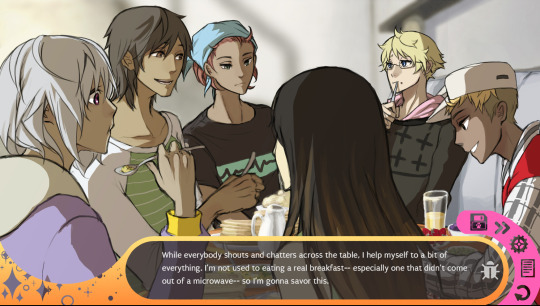
- Hustle Cat, an adorable dating sim, I think you’d love it, Erissea :D You play as Avery, who is probably the most relatable playeable character ever, as their life changes when they begin to work in a cat cafe. Contents include magic, cute romance, friendship, and lots of cats. The writing is extremely natural and refreshing, and you can customize Avery (pronouns: he/she/they, appearance and skin colour). Male and female romance options.
- Black Closet, in which you play Elsa, a high-profile student and president of the student council in an all-girls boarding school, and try to maintain the reputation of the school. It’s a mixture between a visual novel and a cards game, with five female romance options. The art is gorgeous.
VNs that are hugely centered around characters and storytelling:
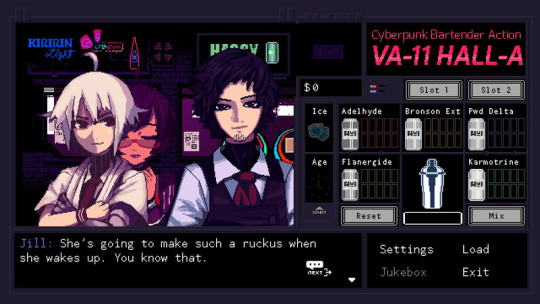
- VA-11 Hall-A: Cyberbunk Bartender Action: It’s a very, very good game that was released last year and takes place in a dystopian future inspired by the current situation in Venezuela (where the developers live): there is a lot of corruption, political instability and price inflation is out of control. You play as Jill, a bartender struggling with adult life, and listen to all your clients’s life stories. The interface is pretty innovative, as it lets you create drinks while you’re talking, and these replace the traditional choices you normally make in VNs. There is a lot of reading involved but the cast is incredibly diverse and strongly-written. Also the music is A+++.
- Hatoful Boyfriend (and its sequel, Holiday Star): I know, this game, at first, sounds like a joke. You play as Hiyoko, the only human present in a school for pigeons. There is a ~dating sim aspect, which is pretty hilarious to play, but soon you discover that there is a real, pretty grim, story and lots of layers at the core of this game. It’s definitely one of my favourite visual novels, but I can understand why it doesn’t necessary appeal to everyone.

- Analogue, A Hate Story and Hate Plus: these two games are in my opinion a must-have for visual novels lovers who are interested in reading an engaging and complex story and aren’t afraid of being confronted to new means to present a narrative. You’re a space investigator from the very end of the 50th century who finds the remnants of an old Korean spaceship that never arrived to its intended destination. Your goal is to access the files of the ship and understand what happened. There are two main characters (artificial intelligences who have the appearance of women) present, and each of the games (Hate Plus being the direct sequel to Analogue) tell the story of one of them. I have to warn that the themes are very heavy (most notably the oppression of women in an archaic-thinking society) but there are also cute moments and a lot of humour, and it’s definitely one of the most compelling and thought-provoking pieces of media and literature I’ve read in months if not years.
- Read Only Memories: It’s set in the same universe as VA-11 Hall-A, which is to say in the year 2064, but in San Fransisco this time. You’re a journalist whose latest, unforeseen job is to help the most adorable robot in the universe, Turing, to find why their creator disappeared. To be perfectly honest, it is as much a point and click as a visual novel but this game is very endearing and honest. There is pronouns customization, a very diverse cast and lots of interesting reflections about human nature and artificial intelligence. Also it’s entirely in pixel art, so not for everyone I guess (voice-acting is coming very soon though).
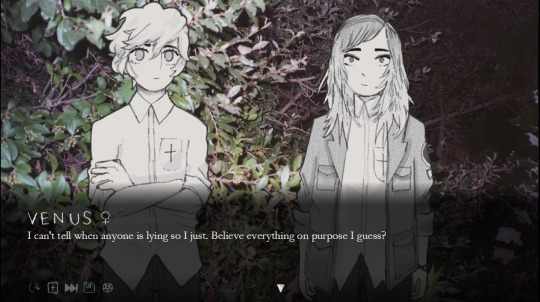
And last but not least, a VN I consider to be pretty much an oddity in the genre of visual novels but a great work of art nonetheless, We Know the Devil. It’s a very short VN (approx. 1 hour per route, and there are three of them) about being queer and young and lonely. Ultimately it’s a story about learning to love oneself and accepting who we are. There is a lot left to interpretation but it’s definitely a moving game, and the mix of ‘traditional’ art and real-life photography for the background helps to create a unique atmosphere. (I want to precise that despite its title and some pretty intense moments, this is not an horror game >-<)
I reckon that if you’re interested in otome games, Nameless, the one thing you must recall has a very good reputation, but I haven’t played it yet so I can’t judge !
#Pictures are in order: Cinders/Hustle Cat/VA-11 Hall-A/Hate Plus/We Know the Devil#just in case#anyway I hope it helps you Erissea#all of them are really good in my book#even though none of those is otome#if you're curious about one of them don't hesitate to ask for more details#I'm always here to answer questions and stuff :D#Video Games#My posts
3 notes
·
View notes
Text
Game 363: Ultima VII: The Black Gate
A deceptively pleasant introductory screen.
Ultima VII: The Black Gate
United States
ORIGIN Systems (developer and publisher)
Released in 1992 for DOS; 1994 for SNES
Forge of Virtue expansion released later in 1992 for DOS
Date Started: 20 March 2020
I first played Ultima VII in 1999. I had just purchased my first Windows laptop after 7 years of Mac-exclusive ownership, and I was ready to catch up on a decade of RPGs. I had staved off my addiction while serving in the Army Reserves, going to college, meeting my eventual wife, and starting my career, and it was best for all of those endeavors that I did. But life had settled down by then, and I was ready to take the risk.
The first two “new” RPGs that I played were Might and Magic VI and Ultima VII. (“New” being post-1990, when my Commodore 64 had died. By then, Ultima VII was 7 years old, of course, but I still think of it on the “new” side of the dividing line between “old” games and “new” games.) I had a similar reaction to each of them: initial distaste, followed by growing admiration, followed by absolute awe.
This may be the first CRPG with an expansion pack that takes place within the main quest.
But I still remember the reasons behind my initial reaction, and a few of them remain valid criticisms. I bought it as part of an Ultima anthology, so I would have played it after hitting Ultima IV-VI in quick succession. Compared to the small, crisp icons of the previous games, the Ultima VII characters seemed impossibly lanky and awkward. The creators must have taken to heart the criticisms of the tiny Ultima VI game window because they made the entire screen the game window–but then they zoomed it in so much that you still only see a tiny area.
They removed the ability to choose a character portrait, and I hated–still hate, really–the long blond-haired jerk that I’m forced to play. The guy looks like he’s about 50, which doesn’t bother me as much today as it did then. The typed keyword-based dialogue that I absolutely cherished had been replaced by clicking on words spoon-fed to you by the game. And then there was all the clicking! For the first time, the Ultima interface wasn’t using my beloved keyboard shortcuts but instead wanted me to click around on things. I hate that now and I hated it more then, when the mouse was still new and uncomfortable.
I still find everything about this screen annoying.
Finally, there was the plot. 200 years have passed?! And all my old companions are still alive?! Who is this Red Thanos taunting me through the computer screen? And what in Lord British’s name have they done to Lord British?!
This is all to say that I’m glad I’m not playing Ultima VII for the first time. This is a game that vastly benefits in a replay, at a point where I’ve accepted its weaknesses but also have a full understanding of its strengths. In fact, the position that I’m in right now–knowing that I’m in for a good game but not remembering much of it because I haven’t played it in maybe 13 years–is just about perfect.
So let’s back up and note all the things that the game does right, starting with the animated, voiced introduction, perfectly scored. The game opens on a pleasant scene of Britannia. A butterfly dances around a grassy hillside at the edge of a forest. There’s a lilting tune with a timbre suggesting an organ but a melody suggesting more of a flute.
The first appearance of the Guardian.
But after a few seconds, the music fades and is replaced with an ominous, themeless tune in a low register. Black and blue static fill the screen. A red face with glowing yellow eyes and teeth like rocks pushes through the screen to address the player directly:
Avatar! Know that Britannia has entered into a new age of enlightenment. Know that the time has finally come for the one true Lord of Britannia to take his place at the head of his people. Under my guidance, Britannia will flourish, and all the people shall rejoice and pay homage to their new Guardian! Know that you, too, shall knell before me, Avatar. You, too, shall soon acknowledge my authority, for I shall be your companion, your provider, and your master!
I would note that in contrast to the comically awful narrations at the beginning of both Ultima Underworld and Ultima VII: Part Two, the Guardian’s voice is reasonably well-acted by Arthur DiBianca, who I gather was just a programmer who happened to have a nice bass voice. The voice immediately gives us a paradox because the Guardian looks like an ape, an orc, a monster, yet his voice is clear, his speech intelligent and articulated. Just what kind of foe are we facing? One who knows who we are, who has the ability to push through into our world.
(Incidentally, having never played Ultima VIII or Ultima IX, I still don’t really know the answers to the questions about the Guardian’s origin and motivations. I know it’ll be tough, but I’d appreciate if no one spoils it.)
As the screen fades, the camera pulls back to show that the player is somehow playing Ultima VII on his computer, with a map of Britannia and a Moonstone sitting beside it. No, it doesn’t make sense. Don’t think about it.
I can’t not think about it. How is my character playing Ultima VII? Does he have his own character? How far down does it go?
“It has been a long time since your last visit to Britannia,” the title screen says, two years constituting “a long time” back in those heady days of annual releases. The character picks up his moonstone and heads out to the circle of stones in his back yard–only to find a moongate already there. Without hesitation, he plunges through to the title screen, which features not the triumphant, adventurous introductory music of most RPGs but rather a dark, dreadful march in 2/4 time. Something awful is coming, it says.
I’m not sure this ever gets answered.
Before we get into character creation and the opening moments of the game, let’s diverge to the manual, which is perhaps the most brilliant game manual of all time–a superlative unlikely to ever be broken now that game manuals no longer exist. It manages to educate the player on the basics of Britannia and the past Ultima games while perfectly serving the plot of the current game. It is the only manual that I know that was written by the game’s villain. I realize that’s a bit of a spoiler, but you’d have to be a particularly dense player to not realize that something is at least a little fishy with “Batlin of Britain,” and a veteran player of the Ultima series reads it with an escalating horror.
The manual is called The Book of Fellowship, and it describes the history, geography, and society of Britannia in the context of the growth of a quasi-religious/philosophical order called the Fellowship. Jimmy Maher has a particularly excellent article examining the parallels between the Fellowship and the Church of Scientology. (Garriott had apparently read a 1991 Time magazine exposé of the Church while the game was in its planning phase.) But I also see a lot of the (then-) growing “prosperity gospel” in the Fellowship, and Batlin strikes me as much of a Joel Osteen (although no one at ORIGIN would have been aware of him in 1992) as an L. Ron Hubbard. One particular analogue with prosperity theology (and not Scientology) is the organization’s “layered” approach to scripture. The Fellowship does not reject the Eight Virtues of the Avatar any more than prosperity theology rejects the Bible. It simply adds its own new layer of interpretation (simplification) on top of them, encouraging its followers to hold true to the past without really focusing on it. The emphasis is all on the new material–in the case of the Fellowship, their Triad of Inner Strength.
The manual begins with Batlin of Britain’s introduction of himself. He presents himself with false humility as just a regular man, a fellow “traveller” through life, who has happened to stumble upon a bit of wisdom that he wants to share. Throughout his biography, he brags-without-bragging that he has served in all eight of the classical Ultima roles: Born and raised by druids in Yew, a first career as a fighter in Jhelom, then as a bard in Britain; trained by a mage from Moonglow; serving for a while among a company of paladins in Trinsic and as a tinker in Minoc; and finally spending a sojourn with the rangers of Skara Brae before ending up as a humble shepherd in New Magincia. His series of portraits through these sessions show a square-jawed, hale, charismatic figure, and it’s no surprise when we actually meet him in-game to find a fatter, oilier version than is presented in the official portraits.
What kind of pretentious jackass divides his own biography into sections called “part the first” and “part the second”?
During his description of overcoming some wounds in Minoc, Batlin says:
A healer there told me that without the proper treatments (for which he charged outrageous prices) I would most probably die! I angrily sent him away. After a time I did mend. I had learned that the healing process takes place mostly in one’s mind and have since placed no trust in healers who greedily prey upon the afflicted.
Here is our first actual contradiction with the world as we’ve come to know it as an Avatar. It manages to parallel Scientology’s rejection of traditional psychology, sure, but also the Christian Science rejection of traditional medicine and perhaps “New Age” medicine in general.
He describes in his history how he met his two co-founders of the Fellowship, Elizabeth and Abraham (the “E.A.” being an intended swipe at Electronic Arts, which would have the last laugh by purchasing ORIGIN the same year), and how his experiences led him to develop the Triad of Inner Strength. If the casual reader is not yet convinced of Batlin’s villainy, it should become apparent in the section where he discusses the “ratification” of the Fellowship by Lord British. Though calling him “wise” and paying him obsequious homage, Batlin manages to paint the king as a capricious, dismissive sovereign, uninterested in the Fellowship until Batlin managed to “prove” himself with a display of confidence that manages to reflect the Fellowship’s own philosophies. The section brilliantly manages to associate Batlin with the king and the king’s favor (for those who still admire the king) while also planting a seed of doubt about Lord British’s fitness to rule.
What he does to the Avatar is less subtle but far more damaging. Batlin knows that if his Fellowship is going to replace the Eight Virtues as Britannia’s predominant theology, and if he himself is going to replace the Avatar as the spiritual figurehead, he must undo the Avatar. But the memory of the Avatar is too popular, his friends too influential, for Batlin to use a direct attack. Thus, he snipes and undermines and saps from all angles while pretending to admire the Avatar himself. “The Fellowship fully supports the Eight Virtues of the Avatar,” he says, but that “it is impossible to perfectly live up to them. Even the Avatar was unable to do so continuously and consistently.” Thus pretending to support the Eight Virtues while rejecting them, he introduces the Fellowship’s Triad of Inner Strength:
Strive for Unity: Work together to achieve common goals.
Trust Thy Brother: Don’t live your life full of suspicion and doubt.
Worthiness Precedes Reward: Do good for its own sake before expecting compensation.
Maher’s article points out how these three principles are not only kindergarten-level theology, but how easy it is to twist them towards evil ends. “Work together, don’t question, don’t ask anything in return” could be the motto of a fascist organization as easily as a charitable one.
Most of the slights against the Avatar occur during the second half of the manual, ominously titled “A Reinterpretation of the History of Britannia.” Batlin walks through the events of Ultima I through VI much as the previous game manuals did, but with the occasional anti-Avatar salvo disguised as support. For instance, after describing the events of Ultima II, he says:
While there have been speculations as to the motivations of the Avatar, there is insufficient evidence to show that the Avatar was driven to violence by jealously over Mondain’s romantic involvement with Minax. That being said, such theories are hereby denounced and should not be given consideration.
Soon afterwards, he “formally disagrees” with “those who say the Avatar should have handled [the events of Exodus] differently.” He casts aspersions–no, sorry, alludes to other people casting aspersions–on the Avatar’s motives in the Quest of the Avatar. As for Ultima VI: “Those who say that this terrible and destructive war could have been prevented had the Avatar not appropriated the Codex from its true owners are merely dissidents who are grossly misinformed.” Leaving aside the fact that the Avatar wasn’t the one who took the Codex, Batlin commits here the slimy politician’s trick of introducing a slur while simultaneously denying it, thus seeding doubt while trying to remain above it. I’ve learned the hard way to at least try to keep politics out of my blog, but it’s literally impossible not to think of Donald (“many people are saying”) Trump when reviewing this aspect of the Batlin character or indeed the Batlin character as a whole. If I didn’t say it here, someone would have filled in the blank in the comments as they did in the Maher article.
Aside from the undermining of the Eight Virtues, Lord British, and the Avatar, the manual is notable for numerous asides that make the veteran player eager to jump in and start swinging his sword. In his description of his time as a fighter, Batlin talks about “unruly lords wag[ing] war against each other . . . over Lord British’s objections.” Clearly, peace has broken down, but why? We later hear that Skara Brae is for some reason a “desolate ruin” (remind me to come back to another Batlin quote when I actually visit Skara Brae). Lock Lake near the city of Cove has become polluted. The town of Paws is said to be languishing in poverty. Some mysterious figure called the “Sultan of Spektran” has set up his own government on the island previously occupied by Sutek. The gargoyles have their own city, called Terfin, but there’s a suggestion that local mines might be exploiting them for labor. Runic writing has fallen out of favor. There have been recent droughts. And worst of all, magic has been breaking down and its practitioners going insane.
Perhaps the biggest shock is that it has been 200 years since the Avatar last visited Britannia. This is presumably since his last visit in Ultima VI, not Ultima Underworld. The manual makes no acknowledgement at all of the events of Underworld; no mention is made of a colony on the Isle of the Avatar, nor its destruction in a volcanic eruption.
Ultima IV: Quest of the Avatar still has the best quest of the series, in my opinion, but Ultima VII may have the best plot. This isn’t the first time that a CRPG has featured writing and plotting worthy of a novel (I would probably give that award to Starflight), but it’s still rare in the era. I understand that we owe this depth of narrative to lead writer Raymond Benson, who would later go on to take over the James Bond novel series. Benson was a playwright and composer who had previously worked on computer adaptations of Stephen King’s The Mist (1985) and the James Bond games A View to a Kill (1985) and Goldfinger (1985). He was recruited by ORIGIN in 1991 and wrote some dialogue for Martian Dreams before beginning Ultima VII.
Someone like Benson was exactly what ORIGIN needed. The company may have “created worlds,” but they always did so in a way that was both a little sloppy and a little too tidy, with poor respect for their own canon. I have discussed at length my disappointment over the way the game treated the concept of “the Avatar” after Ultima IV. Well, here, in the opening documentation of Ultima VII, we have an in-game character who personifies that lack of respect, who manages to take the confusion over ORIGIN’s retcons–was the Avatar really the same hero who defeated Mondain?–and twist it to his own ends. When I finished the manual in 1999, I was never more eager to leap into a world and start putting things right. I am only slightly less eager now.
Note: To avoid loading transitions and other throwbacks to an earlier age, the developers of Ultima VII changed the way DOS allocates memory. Their solution required players to boot from a special disk. I remember that this created all kinds of problems when I originally tried to play the game in the late 1990s. Also, processors had gotten so much faster that the characters moved at lightning speed, and I had to use a special program called Mo’Slo to slow things down. I don’t think I ever got the sound working properly back then. The emulation era and the folks at GOG sure make this much easier.
source http://reposts.ciathyza.com/game-363-ultima-vii-the-black-gate/
0 notes
Text
Kentucky Route Zero review – haunting drifter’s odyssey comes to an end • Eurogamer.net
And so a meandering journey comes to an end. Kentucky Route Zero, “a magical realist adventure game”, was funded, modestly, on Kickstarter back in 2012. The first of its five episodes released in early 2013, the second a few months later, the third a year after that, the fourth two years later still. Now, following the almost exponential trend, after a further three-and-a-half-years, we get the game’s conclusion – alongside a new console edition of the entire series.
Kentucky Route Zero review
Developer: Cardboard Computer
Publisher: Cardboard Computer (PC), Annapurna Interactive (console)
Platform: Reviewed on Switch
Availability: Act 5 released 28th January on PC. Kentucky Route Zero: TV Edition released 28th January on Switch, PS4 and Xbox One
If you’ve been following this game since the start, then, it’s been a long road, and perhaps an exasperating one. Not that this wasn’t a fitting way to experience Kentucky Route Zero’s tale of a band of misfits getting drawn into a truck driver’s quixotic quest to deliver his load of antique furniture to an address that seems to get further away with every step. Some made their peace with the open ending of the fourth act being as good a place as any to leave it – and they weren’t wrong. But I doubt they will be disappointed in the fifth act that releases this week. Strikingly different in style, it’s a gorgeous epilogue that finds resolution while resisting the urge to solve any of the game’s many mysteries.
If you’ve been on this long journey with the game, I envy you. I have played Kentucky Route Zero from start to finish in the space of a week – all five episodes, plus the four interludes that developer Cardboard Computer released for free – and I’m not sure it’s the best way to take it in. Essentially a beautifully illustrated and animated text adventure, Kentucky Route Zero is slow, whimsical, interior, elliptical and at times deliberately frustrating. It is as inspired by theatre and installation art as film or video games; it’s dense with memory, digression and fragmentary, half-remembered lore. It’s not long, but it has too little plot and too much story to be comfortably consumed in one go. Like a meal composed of dozens of dainty side-dishes, it risks leaving you stuffed but unsatisfied. Better to give each portion its space (though three-and-a-half years of space might be overdoing it), to savour the flavours that linger long after you put the game down.
youtube
Conway, the truck driver, asks for directions at a petrol station decorated with a giant horse’s head. In the basement he has the first of many encounters with people – ghosts? – who don’t seem to exist in the same timeframe as him. He is directed to the Zero, a secret, underground, extra-dimensional highway; it’s the only way to reach his destination. Getting to the Zero won’t be easy, but navigating it and the spaces – and people – it leads to will be trickier still. He acquires a travelling companion, Shannon, who loves to repair old TV sets and sees visions of her vanished sister in the white noise. (This game has a strong retro fetish for analogue technology: cathode ray tubes, radio static, magnetic tape, theremins. The suggestion is that these old machines left more room for magic and mystery than the digital world does – a tempting, if heavily nostalgic, point of view.)
Searching for the Zero, Conway and Shannon explore an old mine, where he injures his leg. They find the mystical road, but it only leads them into a bureaucratic purgatory of dead ends, odd characters and illogical institutions. They keep getting sidetracked. There’s a huge bird that carries houses; a game-within-a-game, running on an ancient mainframe computer, that tells the story of its own making; a tugboat navigating an underground river. An orphaned boy joins them, and a cool musical couple, and other lost souls drift in and out of the scene. No-one ever seems to be fully present, being constantly pulled back to their own thoughts, their own reality. The ultimate goal of the delivery is not so much sought as drifted towards.
This is what Cardboard Computer means by magical realism: a recognisably real world where fantastical things can happen and where dream logic holds sway. Kentucky Route Zero is clearly inspired by David Lynch, though not in the totemistic way other video games quote his hugely influential mystery-horror-soap, Twin Peaks. (You know what I mean: red velvet curtains, sharp-suited investigators, torch songs in roadside bars, creeping unease in placid Smalltown, USA.) Plenty of games have indulged in this while pursuing their own more or less conventional concerns, from Deadly Premonition’s outsider-art survival horror to Virginia’s elegant procedural. Kentucky Route Zero gets closer to the unsettling core of Lynch’s work, where the things that ought to make the least sense make the most – where the unreal and impossible has an awful, implacable truth about it. (It does also feature a torch song in a roadside bar, mind.)
In this world, a band of distillery workers appear as glowing skeletons; they make everyone uneasy, but nobody remarks on it. The laws of space and time seem easily pierced or folded, to which characters react with, at most, a vague bemusement. The images and moments Cardboard Computer conjures from this dreamscape have a haunting power. The trouble is that there isn’t quite enough reality in this magical realism. In Lynch, the surreal and horrifying lurch suddenly from a landscape of extreme, almost anaesthetised normality. In Kentucky Route Zero’s middle episodes, however, it plunges into head-spinning concept after head-spinning concept, taking each as far as it will go – a very video gamey thing to do.
At times this is almost alienating, which is a risk when your game gives the player such a slender toehold in the narrative. For all its oddity, this is a pretty linear piece of storytelling in which the choices you make are less about what will happen next and more about the inner lives of the characters: where their memories lead, how curious they are, the song lyrics that haunt them. You spend most of your time in this game reading. The script, by Jake Elliott, is good, with a compassionate humanity that balances the occasional excesses of surreal southern Gothic. I loved the passages when there was a sudden shift in perspective and a voice from a different timeframe would cut through – such as the scene narrated by a couple of bored office workers from the future, reviewing old CCTV tapes.
Kentucky Route Zero is a game of words, but it’s Tamas Kemenczy’s vector visuals for which the game will be remembered. It is extraordinarily beautiful. Small, fragile, hazy figures pick their way through skeletal spaces. The lighting is dim and suggestive, using silhouette and negative space to leave your imagination room to breathe, and there are some startlingly lovely effects. It often looks like a flat, paper-cut diorama until the camera slowly rotates, revealing its surprising solidity and depth.
The game has many obsessions: death, memory, the decline of rural America. There’s a rather heavy-handed subplot about the entire region being in hock to the electric company. But above all else it is fascinated by art. It is full of artworks: videos, songs, installations, poems, and that primitive, fully playable adventure game. Half the characters seem to be artists or frustrated artists. If this sounds dangerously self-referential, well, I suppose it is. It does seem rather preoccupied with the hipster bubble within which it is all too easy to assume the game was created.
Yet some of the game’s most persuasive moments take place within this art-within-art. I’m thinking in particular of two of the interludes (which you can download for free at the game’s site). The Entertainment is a play, experienced from the point of view of one of the performers, that introduces a location and characters that will pop up in the subsequent episode; Un Pueblo De Nada puts us behind the scenes at a tiny community TV broadcast during a torrential downpour, foreshadowing the final act. Both use a single fixed camera point to brilliant effect, creating a strong unity of place and giving a much-needed shot of reality amid the magic – despite the air quotes they appear in.
This trick is repeated by the game’s fifth act, which breaks formally with the fragmentary, collage-like approach of the preceding four. It all plays out in a single location, with a single camera floating high above the action, following the player’s focus (rather sweetly embodied in a gambolling cat). Characters are discovered in different moments and attitudes as the camera sweeps across them and we stop to hear what they have to say. The sun warms the scene and, for the first time, the world of Kentucky Route Zero feels tangible, whole, held together. After a week drifting through Cardboard Computer’s elusive dream of a game, this was quite a moment. I can only imagine how it feels after seven years.
from EnterGamingXP https://entergamingxp.com/2020/01/kentucky-route-zero-review-haunting-drifters-odyssey-comes-to-an-end-%e2%80%a2-eurogamer-net/?utm_source=rss&utm_medium=rss&utm_campaign=kentucky-route-zero-review-haunting-drifters-odyssey-comes-to-an-end-%25e2%2580%25a2-eurogamer-net
0 notes
Text
PSX Review – Resident Evil: Survivor
I’ve been a fan of the Resident Evil series ever since I played the original game round a friend’s house on his PSX. We must have only been 8 years old at the time, so naturally, we didn’t let his parents know what we were playing… However, it was such a brilliant experience, with the adrenaline rush that accompanied so much of the game (especially that corridor, if you know what I mean). I loved it so much that I saved up my pocket money and bought it off my friend, since I’d never be able to get it in an actual shop.
Since then, I’ve played almost of all of the Resident Evil games, including the likes of Resident Evil Gaiden (which was horrible) and the Resident Evil Outbreak series (you can read my review of the first of those games here). I even forced myself through Resident Evil 5 and 6… But, there was one game that stuck in my mind, for all the wrong reasons – Resident Evil: Survivor. Released on the 27th of January, 2000, I got the game as a birthday gift one day after my birthday. I was so excited to play it, as the idea of it seemed amazing. Resident Evil: Survivor is a first-person shooter Resident Evil game with an original side story, which sounds brilliant on paper. However, when I actually played it, it just didn’t click with me. I did finish it, but it felt more like a chore than something fun and exciting.
I didn’t touch the game again after that, letting it collect dust. However, it has been 18 years since then and a lot has changed, myself included. So, what did I think of Resident Evil: Survivor when I went back to play it again? Let’s find out!
Storyline
Right, so as mentioned previously, Resident Evil: Survivor is a side story to the main Resident Evil games. It takes place after the end of Resident Evil and features a brand new set of characters. You play as a man who has suffered from amnesia, having survived a helicopter crash just outside of a township, owned by the Umbrella Corporation. With the entire place infested with zombies and other biological weapons created by Umbrella, you have to both escape alive and figure out who you are.
Now, despite the amnesia angle cliche, that does sound like an intriguing premise to a Survival Horror game. However, as you progress through the game you quickly realise that it is lacking the depth of other Resident Evil games. For example, the backstory you can learn about the Spencer Mansion from the first Resident Evil, or the history of Police Chief Irons in Resident Evil 2, really add to the overall plot. These extra subplots just make everything all the more terrifying and creepy. With Resident Evil: Survivor, nothing really comes close to this, sadly.
The game’s plot twist revolves entirely around the main character’s identity and really doesn’t feel like a shock or surprise at all. On top of this, the actual events of the game don’t really offer much to expand on the world, honestly feeling more like a fan fiction that an actual, canon storyline. Oddly enough, it is amazingly close to a short story I wrote at school in 1998, which was a fan fiction about Claire Redfield from Resident Evil 2.
The story had at least some potential to be different and unique, adding to the mystery of Umbrella or the horrors of their experiments. But in the end, it just felt like something thrown together as quickly as possible, so that the developers could claim there was a plot to this game.
Gameplay
Considering that Resident Evil: Survivor was a first-person Survival Horror shooter, I remember expecting a lot from the game. I’d been playing Medal of Honor a lot and was actually starting to like FPS games. However, one key thing to note is that Resident Evil: Survivor isn’t a standard FPS – it is a light gun game, through and through. This meant that, if you didn’t own a light gun, playing with the controller was a pig, to say the least.
In typical Resident Evil fashion, you had to hold one button to take aim, which would bring up a targeting reticle on the screen. From there, you had to move the reticle around the screen with the D-Pad or Analogue Stick to actually aim at your enemies. This made shooting very tedious and slow, which just ended up making the gameplay feel frustrating.
Even if you do have a light gun, whilst aiming is easier, movement suffers considerably. In order to move around the game world, you have to shoot off screen to move and use the side buttons to turn. This feels very clunky. Oh, and if you have the US version of the game, you actually don’t get the option to use a light gun, as it was removed from that version of the game entirely. On top of this, the Survival Horror aspect of the game died a lot once you realised that you have infinite ammunition for the handguns.
Graphics
Resident Evil: Survivor uses the same enemy models as Resident Evil 2, which were really quite good for the time that game was released. However, it is important to note that Resident Evil 2 was released in January 1998, a full two years before Resident Evil: Survivor. As such, when Survivor did come out, it felt somewhat outdated in terms of visuals. This was only compounded by the fact that you were now looking at two-year-old zombie models up close and personal.
Even the character animations during cutscenes felt out of touch with game design for the time, still using the same engine as the older Resident Evil games.
That’s not to say that the graphics were horrible. As mentioned earlier, they were recycled from Resident Evil 2, which looked awesome at the time it was released. The problem for Resident Evil: Survivor was that two full years (almost to the day) had gone by and there didn’t seem to be any improvement or progress to the graphical design at all. The fact that you are now looking at these graphics in the first person really didn’t help either.
And That’s All Folks
Overall, Resident Evil: Survivor had the potential to be a great side story game, like the Resident Evil Outbreak series. However, due to clunky gameplay and a cliche story that doesn’t offer anything of any real interest, it feels more like a cheap cash-in to just get more sales from the Resident Evil name.
Every series has that one bad apple in it and whilst most people these days will say that Resident Evil 5 or 6 fits that idea, they are at least enjoyable in some capacity. However, Resident Evil: Survivor is just such a dull, boring and frustrating game. If you’re trying to get a full collection of the franchise, then pick this one up. If not, then I would recommend avoiding it like you would the T-Virus itself.
from More Design Curation https://www.16bitdad.com/psx-review-resident-evil-survivor/?utm_source=rss&utm_medium=rss&utm_campaign=psx-review-resident-evil-survivor
source https://smartstartblogging.tumblr.com/post/172842412450
0 notes
Photo

For the week of 28 January 2019
Quick Bits:
Amazing Spider-Man #14 begins “Family Matters” as Chris Bachalo and his army of inkers (Al Vey, Wayne Faucher, John Livesay, and Tim Townsend) join Nick Spencer and Joe Caramagna. The art is gorgeous, with some interesting layouts and beautiful washes for flashbacks, as we get a bit of an advancement on the simmering Kraven plot.
| Published by Marvel

Batgirl #31 complicates matters further in the Alejo and Moore election campaigns as Babs tries to work out who Cormorant is, who he’s working for, and what’s happening. The politicking and mystery of Mairghread Scott’s script is very compelling.
| Published by DC Comics
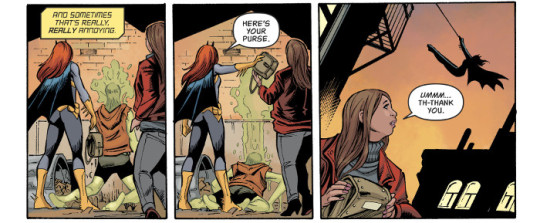
Captain America #7 begins the next stage of this epic, with the first part of “Captain of Nothing” from Ta-Nehisi Coates, Adam Kubert, Frank Martin, and Joe Caramagna. This one’s fairly meaty as the conspiracy to eliminate Cap from the board continues to come down around him as he deals with the consequences of being framed for the murder of General Ross. I’m very impressed with Adam Kubert’s art here, between this and his work on Soldier Supreme, he seems to have levelled up his already wonderful art again. Some very inventive layouts and panel staging, while also employing excellent use of 9-panel grids, that make this a treat.
| Published by Marvel

Crimson Lotus #3 continues to be an entertaining mix between the paranormal and a spy thriller from John Arcudi, Mindy Lee, Michelle Madsen, and Clem Robins. It’s also quite funny to see Agent Dai’s reaction to the supernatural.
| Published by Dark Horse

Cyber Force #8 hits round two against Leviathan while Dominique comes to terms with her new status quo. Matt Hawkins and Bryan Hill attempt to show us more complications of the new cyber order, beautifully brought to life by Atilio Rojo.
| Published by Image / Top Cow
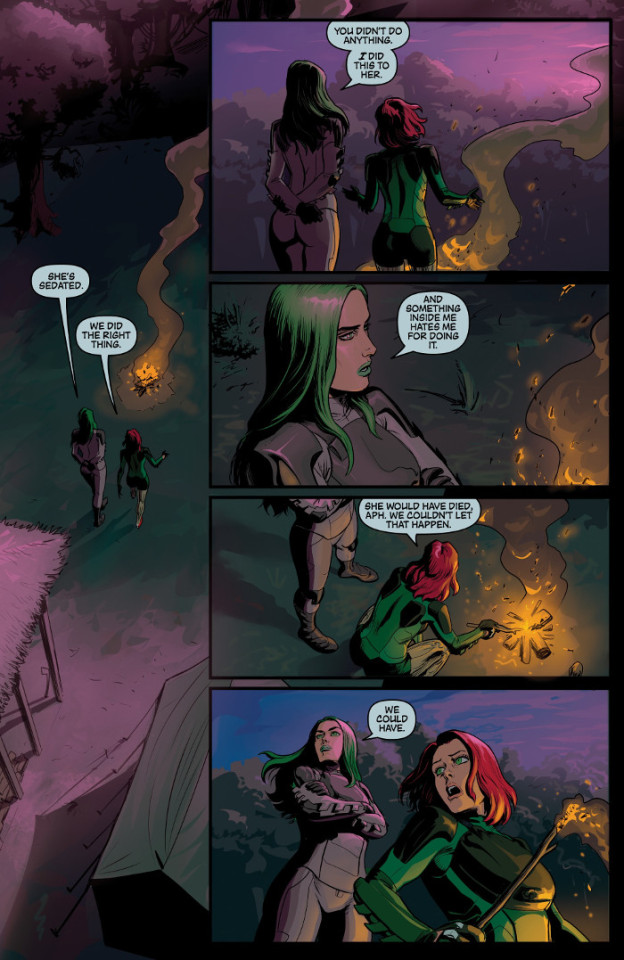
Detective Comics #997 pits Batman and a strangely alive Thaddeus Brown against sharks, piranhas, drowning, and that shape-shifting beast that has been dogging everyone since “Mythology” started. This is like a demented memory lane from Peter Tomasi, Doug Mahnke, Christian Alamy, Mark Irwin, David Baron, and Rob Leigh.
| Published by DC Comics
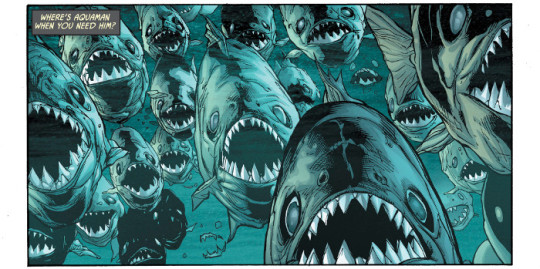
Doctor Strange #10 offers up the beginning to a new wrinkle in a story that has been building since the first issue from Mark Waid, Jesús Saiz, and Cory Petit in the lead to this extra-sized anniversary issue. This magic accountancy office reminds me a bit of the revelation of the Time Variance Authority. There are also three back-up stories and an art piece to round out the issue.
| Published by Marvel

Fight Club 3 #1 is visually stunning. Like with Fight Club 2, Cameron Stewart is pushing himself to create some of the most inventive, complex, and unique art of his career. Breaking planes, panel structure, and framing within the panels themselves continue to create a blurred reality mirroring the fractured nature of the story itself. It’s good, as Chuck Palahniuk, Stewart, Dave McCaig, and Nate Piekos continue to challenge readers.
| Published by Dark Horse

The Flash #63 concludes the “Force Quest” arc with a confrontation with Gemini and a revelation about the Forces. It kind of echoes the darkness and depression that’s been creeping back into the DC Universe in recent months. Great art from Minkyu Jung and Hi-Fi.
| Published by DC Comics

The Flash Annual #2 brings the tragedy of Heroes in Crisis into the Flash’s world, following on his learning of Wally’s death in Flash #63, from Joshua Williamson, Scott Kolins, Luis Guerrero, and Wes Abbott. It’s interesting to see all of the current speedsters, but this also raises some questions about Impulse, who seems to be the pre-New 52 incarnation confused about what’s happened (and feeding in to Young Justice, raising even more questions about that as well).
| Published by DC Comics

Ice Cream Man #9 begins “Hopscotch Mélange” and does something different. Since the beginning, this series has been an odd mix of different horror and surrealist pieces ostensibly tied together by the presence of the titular “Ice Cream Man”. This issue presents a “time before” beginning to explain the story of the Ice Cream Man and the cowboy who follows him in what feels like a mash-up of Grant Morrison and Stephen King. It’s good. Weird as hell, but good. W. Maxwell Prince, Martín Morazzo, Chris O’Halloran, and Good Old Neon continue to work wonders with this story.
| Published by Image
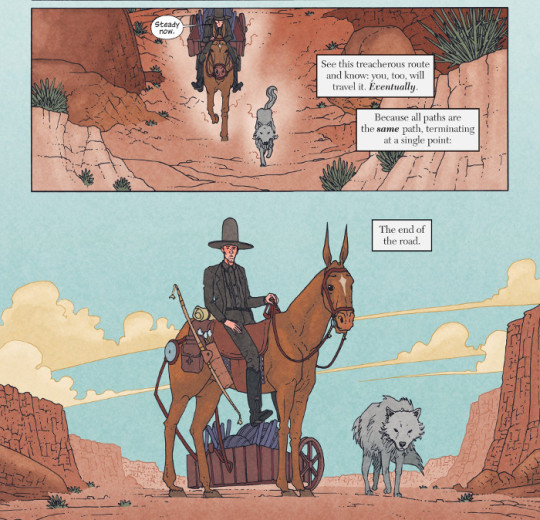
Infinite Dark #4 brings the first arc to an end with a revelation as to what the entity is (or at least claims to be) as the crew tries to find a solution to absolute destruction from Ryan Cady, Andrea Mutti, K. Michael Russell, and Troy Peteri. This is a wonderful blend of horror and sci-fi with some great character moments.
| Published by Image / Top Cow
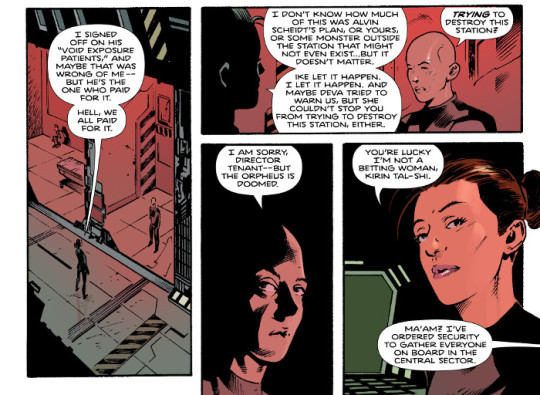
James Bond 007 #3 continues the action as Bond and Lee fight over who gets the Russian smuggler. Marc Laming and Roshan Kurichiyanil are doing an incredible job with the artwork.
| Published by Dynamite

Journey into Unknown Worlds #1 is another of the 80th anniversary one-shots, this one offering a pair of horror out of space stories; one from Cullen Bunn and Guillermo Sanna, the other from Clay McLeod Chapman and Francesco Manna, both anchored by Lee Loughridge and Travis Lanham. They’re good. Very classic body horror approach.
| Published by Marvel
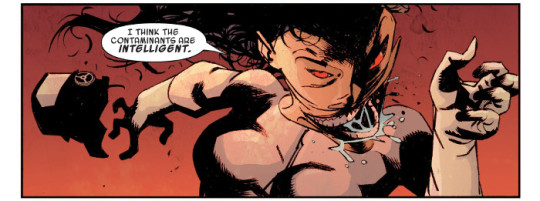
Justice League Annual #1 is a major turning point in the series as Starman, the Justice League, and the major cosmic players attempt to fix the Source Wall in this tale from Scott Snyder, James Tynion IV, Daniel Sampere, Juan Albarran, Adriano Lucas, and Tom Napolitano. It’s epic and definitely not to be missed in regards to what’s coming next for DC’s multiverse.
| Published by DC Comics

Justice League Odyssey #5 pulls back the curtain and gives us an insight into Darkseid’s plan and the purpose of the Ghost Sector. It’s nice to see some guiding force here amongst the chaos of the first four issues. Beautiful artwork from Carmine Di Giandomenico and Ivan Plascencia. Plascencia’s colours are particularly impressive with the starscapes.
| Published by DC Comics

KINO #13 drops a few more bombs on the narrative as it twists what’s going on even further into a delicious, mind-bending pretzel. Also a return to the old school superhero-inspired style within a virtual reality space. Alex Paknadel, Diego Galindo, Adam Guzowski, and Jim Campbell are turning in some incredible work here. Highly recommended.
| Published by Lion Forge / Catalyst Prime

Man Without Fear #5 concludes this mini with Matt continuing to be haunted by his fear as Danilo S. Beyruth returns to close out the art chores. Jed MacKay’s use of narration throughout the series has been well done, but I think this one ups the ante as Matt’s fear and the memory of his father fight to shine through.
| Published by Marvel

Marvel Knights #6 gives us an end from Donny Cates, Kim Jacinto, Travel Foreman, Richard Friend, Matt Milla, and Cory Petit that delivers on action and hints at a future nightmare that the combined heroes were trying to prevent.
| Published by Marvel

Peter Cannon: Thunderbolt #1 is a sequel to Watchmen. Kind of. Kieron Gillen, Caspar Wijngaard, Mary Safro, and Hassan Otsmane-Elhaou pick up on the squid ending, here re-envisioned as a spidery alien invasion and run with it from there. Where Peter Cannon is restored, many of the Charlton heroes are reimagined again, and Rorschach/The Question is interestingly replaced with an analogue to another Steve Ditko creation, The Creeper. It’s both entertaining and fairly meta. Gorgeous artwork from Wijngaard and Safro, even playing with the variations on the 9-panel grid structure famously used in Watchmen itself.
| Published by Dynamite
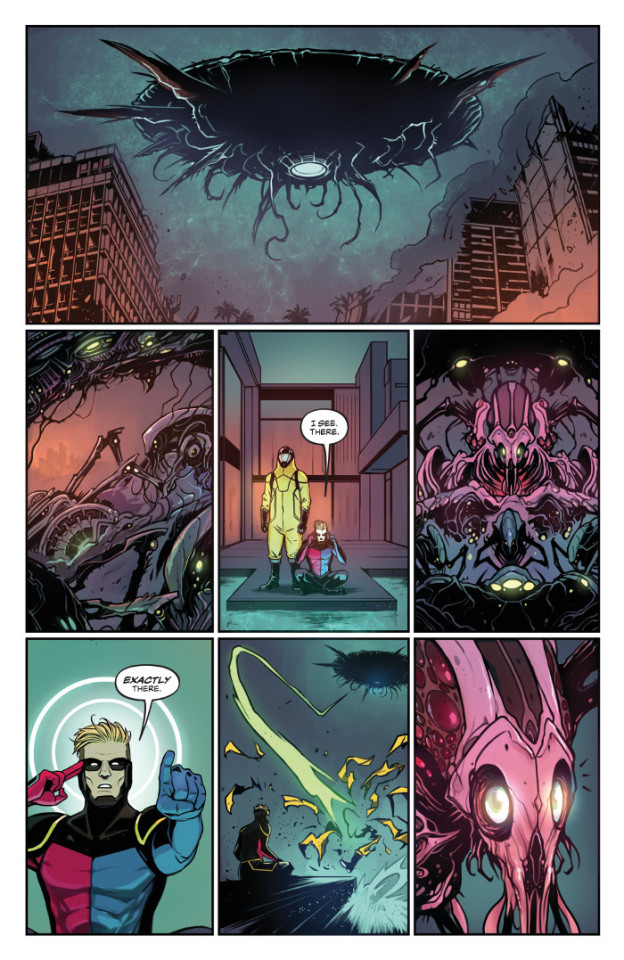
Rick & Morty vs. Dungeons & Dragons #4 brings this fun crossover adventure from Patrick Rothfuss, Jim Zub, Troy Little, Leonardo Ito, and Robbie Robbins to an end. This has been a great series, tapping into both properties extremely well and telling an entertaining story that does both Rick & Morty and D&D justice.
| Published by IDW & Oni Press

The Silencer #13 gives us the origin of Honor and her training through the League of Assassins as a child and being picked early by Talia al Ghul to be her personal assistant/bodyguard by Dan Abnett, V. Ken Marion, Sandu Florea, Mike Spicer, and Tom Napolitano. It’s interesting how it fills in the backstory, while giving a twist for what’s potentially coming in a future with this past erased.
| Published by DC Comics

Sparrowhawk #4 builds Artemisia and her motley pair of fairy compatriots up towards a conclusion in this penultimate issue from Delilah S. Dawson, Matias Basla, Rebecca Nalty, and Jim Campbell. There’s some very interesting character work as Artemisia continues to change and lose more and more of her humanity as she tries to get back home.
| Published by BOOM! Studios
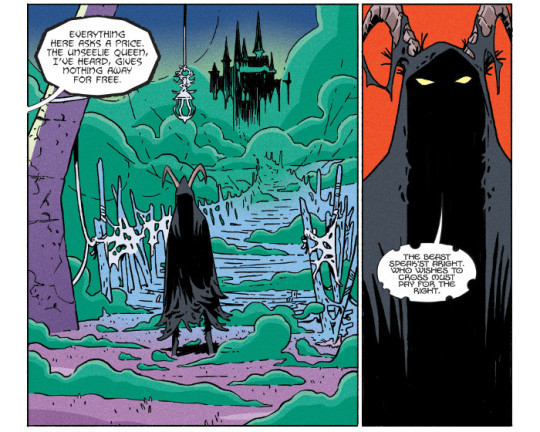
Star Trek: The Q Conflict #1 begins with stars unexpectedly going nova across the Beta Quadrant, leading to Picard and the Enterprise-E investigating. Scott Tipton, David Tipton, David Messina, Elisabetta D’Amico, Alexandra Alexakis, and Neil Uyetake capture the tone and appearance of The Next Generation perfectly and it gets more interesting as the conflict develops.
| Published by IDW

Star Trek - The Next Generation IDW 20/20 #1 takes us back 20 years to Picard’s first command aboard the Stargazer from Peter David, JK Woodward, and Gilberto Lazcano. Beautiful artwork from Woodward, very nicely capturing the likenesses.
| Published by IDW

West Coast Avengers #7 introduces Jeff, the land shark puppy, and he’s adorable. Kelly Thompson, Daniele Di Nicuolo, Tríona Farrell, and Joe Caramagna also pack this confrontation with Madame Masque and her new West Coast Masters of Evil with humour and action, but, seriously, you’re buying this for the shark puppy. Everybody needs a shark puppy.
| Published by Marvel
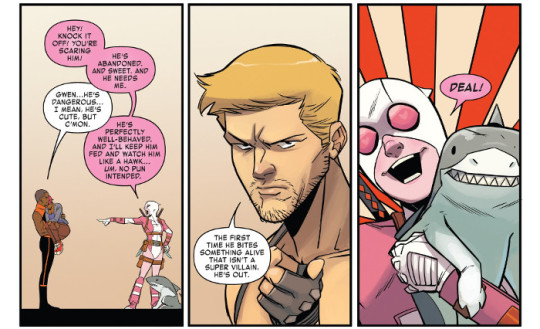
Wonder Woman #63 is a fairly humorous take on the trio of displaced mythological beasts as they try to adapt to America from G. Willow Wilson, Emanuela Lupacchino, Ray McCarthy, Romulo Fajardo Jr., and Pat Brosseau. A lot of Wilson’s run so far has reminded me of Greg Rucka’s first run and that’s reinforced here with a return of one of his (and Drew Johnson’s) creations.
| Published by DC Comics

Wyrd #1 is a solid debut from Curt Pires, Antonio Fuso, Stefano Simeone, and Micah Myers playing in the Warren Ellis-end of the comics sandbox with a seemingly invulnerable, tough-as-nails investigator/operative into the weird. The art from Fuso and Simeone perfectly conveys a world where something feels like it’s seriously gone wrong.
| Published by Dark Horse
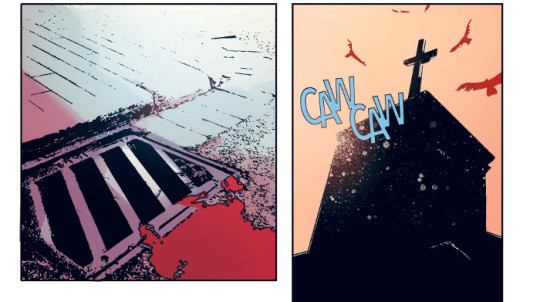
Other Highlights: Action Comics #1007, Animosity: Evolution #10, Betty & Veronica #2, Bone Parish #6, Books of Magic #4, Call of Duty: Zombie 2 #4, Daughters of the Dragon #3, Edgar Allan Poe’s Snifter of Terror #4, Elvira: The Shape of Elvira #1, Hex Wives #4, Invader Zim #39, Iron: Or the War After, Jim Henson’s Labyrinth: Coronation #10, The Lone Ranger #4, Mighty Morphin Power Rangers #35, Ms. Marvel #37, Mysteries of Love in Space #1, Night Moves #3, Old Lady Harley #4, The Punisher #7, Quantum Age #6, Redlands #10, Rick & Morty #46, Robots vs. Princesses #4, Solo: A Star Wars Story #4, Spawn #293, Spider-Man/Deadpool #45, Star Wars: Doctor Aphra #28, Star Wars Adventures #17, Teen Titans Annual #1, TMNT: Urban Legends #9, The Unstoppable Wasp #4, Vampirella: Roses for the Dead #3, Volition #4, Witchblade #11
Recommended Collections: Bad Machinery - Volume 7: The Case of the Forked Road, The Collected Toppi - Volume 1: The Enchanted World, Deep Roots - Volume 1, DuckTales - Volume 4: Fowl Play, Ghostbusters: Crossing Over, Her Infernal Descent - Volume 1, Pathfinder: Spiral of Bones, Shanghai Red, Submerged - Volume 1, Star Wars: Darth Vader - Volume 4: Fortress Vader, Sword of Ages - Book One: Avalon, Transformers: Lost Light - Volume 4

d. emerson eddy keeps on slipping into the future.
0 notes